Ethiopia
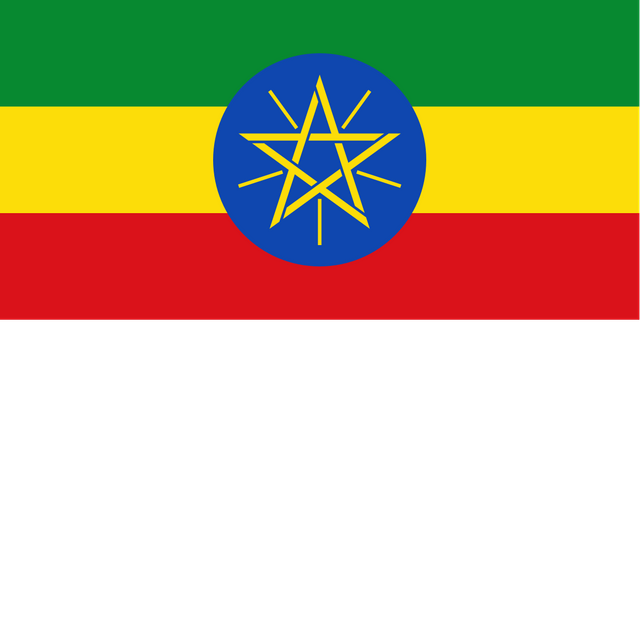
Ethiopia

| Capital | Addis Ababa |
|---|---|
| Official languages | Amharic(federal level | de jure lingua franca)[1] |
| Foreign languages | |
| Religion | |
| Demonym(s) | Ethiopian |
| Government | Federaldominant-party parliamentary republic |
| Sahle-Work Zewde | |
| Abiy Ahmed Ali | |
| Demeke Mekonnen | |
| Tagesse Chafo | |
| Meaza Ashenafi | |
| Legislature | Federal Parliamentary Assembly |
| House of Federation | |
| House of Peoples' Representatives | |
| Formation | |
| c. 980 | |
| c. 100 | |
| 900 | |
| 1137 | |
| 1936 | |
| 1941 | |
| 1974 | |
| 1987 | |
| 21 August 1995 | |
| Area | |
| 1,104,300[7]km (426,400 sq mi) (28th) | |
| 0.7 | |
| Population | |
| 102,403,196[8](12th) | |
| 73,750,932[9] | |
| 92.7/km (240.1/sq mi) (123rd) | |
| GDP | 2019 estimate |
| $240.705 billion[10] | |
| $2,516[10] | |
| GDP | 2019 estimate |
| $90.968 billion[10] | |
| $951[10] | |
| Gini | |
| HDI | |
| Currency | Birr(ETB) |
| Time zone | (EAT) |
| Driving side | right |
| Calling code | +251 |
| ISO 3166 code | ET |
| Internet TLD | .et |

The traditional flag of Ethiopia
Ethiopia (/ˌiːθiˈoʊpiə/; Amharic: ኢትዮጵያ, ʾĪtyōṗṗyā, listen, Tigrinya: ኢትዮጵያ, Oromo: Itoophiyaa, Somali: Itoobiya), officially the Federal Democratic Republic of Ethiopia (የኢትዮጵያ ፌዴራላዊ ዲሞክራሲያዊ ሪፐብሊክ, yeʾĪtiyoṗṗya Fēdēralawī Dēmokirasīyawī Rīpebilīk, listen ), is a country in the northeastern part of Africa, known as the Horn of Africa. It shares borders with Eritrea to the north, Djibouti to the northeast, the de facto state of Somaliland and Somalia to the east, Kenya to the south, South Sudan to the west and Sudan to the northwest. With over 102 million inhabitants,[8] Ethiopia is the most populous landlocked country in the world and the second-most populous nation on the African continent with a total area of 1,100,000 square kilometres (420,000 sq mi). Its capital and largest city is Addis Ababa, which lies a few miles west of the East African Rift that splits the country into the Nubian and Somali tectonic plates.[3]
Some of the oldest skeletal evidence for anatomically modern humans has been found in Ethiopia.[13] It is widely considered as the region from which modern humans first set out for the Middle East and places beyond.[14][15][16] According to linguists, the first Afroasiatic-speaking populations settled in the Horn region during the ensuing Neolithic era.[17] Tracing its roots to the 2nd millennium BCE, Ethiopia's governmental system was a monarchy for most of its history. Oral literature tells that the monarchy was founded by the Solomonic dynasty of the Queen of Sheba, under its first king, Menelik I.[18] In the first centuries, the Kingdom of Aksum maintained a unified civilization in the region,[19]%20for%20Class%20XI%2C%20]] [20][22]Ethiopian Empire Scramble for Africa erved their sovereignty from long-term colonisation by a European colonial power and many newly-independent nations on the continent subsequently adopted its flag colours. The country was occupied by Italy in 1936 and became Italian Ethiopia (part of Italian East Africa) until it was liberated during World War II. Ethiopia was also the first independent member from Africa of the 20th-century League of Nations and the United Nations.[23] In 1974, the Ethiopian monarchy under Haile Selassie was overthrown by the Derg, a communist military government backed by the Soviet Union. In 1987, the Derg established the People's Democratic Republic of Ethiopia, but it was overthrown in 1991 by the Ethiopian People's Revolutionary Democratic Front, which has been the ruling political coalition since.
Ethiopia and Eritrea use the ancient Ge'ez script, which is one of the oldest alphabets still in use in the world.[24] The Ethiopian calendar, which is approximately seven years and three months behind the Gregorian calendar, co-exists alongside the Borana calendar. A majority of the population adheres to Christianity (mainly the Ethiopian Orthodox Tewahedo Church and P'ent'ay) and the historical Kingdom of Aksum was one of the first states to officially adopt the religion, whereas around a third follows Islam (primarily Sunni). The country is the site of the Migration to Abyssinia and the oldest Muslim settlement in Africa at Negash. A substantial population of Ethiopian Jews, known as Bete Israel, also resided in Ethiopia until the 1980s.[25][26] Ethiopia is a multilingual nation with around 80 ethnolinguistic groups, the four largest of which are the Oromo, Amhara, Somali and Tigrayans. Most people in the country speak Afroasiatic languages of the Cushitic or Semitic branches. Additionally, Omotic languages are spoken by ethnic minority groups inhabiting the southern regions. Nilo-Saharan languages are also spoken by the nation's Nilotic ethnic minorities. Oromo is the most populous language by native speakers, while Amharic is the most populous by number of total speakers and serves as the working language in the federal government. Ge'ez remains important as a liturgical language, both for the Ethiopian Orthodox Tewahedo Church, Eritrean Orthodox Tewahedo Church, and for the Beta Israel (Ethiopian Jews).
The nation is a land of natural contrasts, with its vast fertile west, its forests, and numerous rivers, and the world's hottest settlement of Dallol in its north. The Ethiopian Highlands are the largest continuous mountain ranges in Africa, and the Sof Omar Caves contains the largest cave on the continent. Ethiopia also has the most UNESCO World Heritage Sites in Africa.[27] Additionally, the sovereign state is a founding member of the UN, the Group of 24 (G-24), the Non-Aligned Movement, G-77 and the Organisation of African Unity. Its capital city Addis Ababa serves as the headquarters of the African Union, the Pan African Chamber of Commerce and Industry, the United Nations Economic Commission for Africa, the African Standby Force, and many of the global NGOs focused on Africa. In the 1970s and 1980s, Ethiopia experienced civil conflicts and communist purges, which hindered its economy. The country has since recovered and now has the largest economy (by GDP) in East Africa, having the largest population in the region.[28][29][30]
| Capital | Addis Ababa |
|---|---|
| Official languages | Amharic(federal level | de jure lingua franca)[1] |
| Foreign languages | |
| Religion | |
| Demonym(s) | Ethiopian |
| Government | Federaldominant-party parliamentary republic |
| Sahle-Work Zewde | |
| Abiy Ahmed Ali | |
| Demeke Mekonnen | |
| Tagesse Chafo | |
| Meaza Ashenafi | |
| Legislature | Federal Parliamentary Assembly |
| House of Federation | |
| House of Peoples' Representatives | |
| Formation | |
| c. 980 | |
| c. 100 | |
| 900 | |
| 1137 | |
| 1936 | |
| 1941 | |
| 1974 | |
| 1987 | |
| 21 August 1995 | |
| Area | |
| 1,104,300[7]km (426,400 sq mi) (28th) | |
| 0.7 | |
| Population | |
| 102,403,196[8](12th) | |
| 73,750,932[9] | |
| 92.7/km (240.1/sq mi) (123rd) | |
| GDP | 2019 estimate |
| $240.705 billion[10] | |
| $2,516[10] | |
| GDP | 2019 estimate |
| $90.968 billion[10] | |
| $951[10] | |
| Gini | |
| HDI | |
| Currency | Birr(ETB) |
| Time zone | (EAT) |
| Driving side | right |
| Calling code | +251 |
| ISO 3166 code | ET |
| Internet TLD | .et |
Nomenclature
The Greek name Αἰθιοπία (from Αἰθίοψ, Aithiops, 'an Ethiopian') is a compound word, derived from the two Greek words, from αἴθω + ὤψ (aitho "I burn" + ops "face"). According to the Perseus Digital Library, the designation properly translates as Burnt-face in noun form and red-brown in adjectival form.[31] The historian Herodotus used the appellation to denote those parts of Africa below the Sahara that were then known within the Ecumene (inhabitable world).[32] However, the Greek formation may be a folk etymology for the Ancient Egyptian term athtiu-abu, which means 'robbers of hearts'.[33] This Greek name was borrowed into Amharic as ኢትዮጵያ, ʾĪtyōṗṗyā.
In Greco-Roman epigraphs, Aethiopia was a specific toponym for ancient Nubia.[34] At least as early as c. 850,[35] the name Aethiopia also occurs in many translations of the Old Testament in allusion to Nubia. The ancient Hebrew texts identify Nubia instead as Kush.[36] However, in the New Testament, the Greek term Aithiops does occur, referring to a servant of the Kandake, the queen of Kush.[37]
Following the Hellenic and Biblical traditions, the Monumentum Adulitanum, a third century inscription belonging to the Aksumite Empire, indicates that Aksum's then ruler governed an area which was flanked to the west by the territory of Ethiopia and Sasu. The Aksumite King Ezana would eventually conquer Nubia the following century, and the Aksumites thereafter appropriated the designation "Ethiopians" for their own kingdom. In the Ge'ez version of the Ezana inscription, Aἰθιόποι is equated with the unvocalized Ḥbštm and Ḥbśt (Ḥabashat), and denotes for the first time the highland inhabitants of Aksum. This new demonym would subsequently be rendered as ’ḥbs (’Aḥbāsh) in Sabaic and as Ḥabasha in Arabic.[34]
In the 15th-century Ge'ez Book of Aksum, the name is ascribed to a legendary individual called Ityopp'is. He was an extra-Biblical son of Cush, son of Ham, said to have founded the city of Axum.[38]
In English, and generally outside of Ethiopia, the country was once historically known as Abyssinia.
This toponym was derived from the Latinized form of the ancient Habash.[39]
History
Prehistory
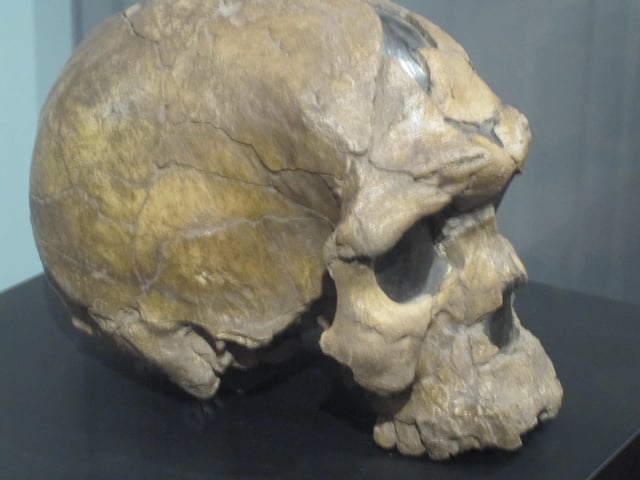
A Homo sapiens idaltu
Several important finds have propelled Ethiopia and the surrounding region to the forefront of palaeontology. The oldest hominid discovered to date in Ethiopia is the 4.2 million year old Ardipithicus ramidus (Ardi) found by Tim D. White in 1994.[40] The most well known hominid discovery is Australopithecus afarensis (Lucy). Known locally as Dinkinesh, the specimen was found in the Awash Valley of Ethiopia's Afar Region in 1974 by Donald Johanson, and is one of the most complete and best preserved adult Australopithecine fossils ever uncovered. Lucy's taxonomic name refers to the region where the discovery was made. The hominid is estimated to have lived 3.2 million years ago.[41][42][43]
Ethiopia is also considered one of the earliest sites of the emergence of anatomically modern humans, Homo sapiens. The oldest of these local fossil finds, the Omo remains, were excavated in the southwestern Omo Kibish area and have been dated to the Middle Paleolithic, around 200,000 years ago.[44] Additionally, skeletons of Homo sapiens idaltu were found at a site in the Middle Awash valley. Dated to approximately 160,000 years ago, they may represent an extinct subspecies of Homo sapiens, or the immediate ancestors of anatomically modern humans.[45] Homo sapiens fossils excavated at the Jebel Irhoud site in Morocco have since been dated to an earlier period, about 300,000 years ago.[46]
According to linguists, the first Afroasiatic-speaking populations arrived in the region during the ensuing Neolithic era from the family's proposed urheimat ("original homeland") in the Nile Valley,[17] or the Near East.[47] Other scholars propose that the Afroasiatic family developed in situ in the Horn, with its speakers subsequently dispersing from there.[48]
In 2019, archaeologists discovered a 30,000-year-old Middle-Stone Age rock shelter at the Fincha Habera site in the Bale Mountains of Ethiopia at an elevation of 3,469 metres above sea level. At this high altitude humans are susceptible to both hypoxia and extreme weather. According to a study published in the journal Science, this dwelling is proof of the earliest permanent human occupation at high altitude yet discovered. Thousands of animal bones, hundreds of stone tools, and ancient fireplaces were discovered, revealing a diet that featured giant mole rats.[49][50][51][52][53][54][55]
Antiquity
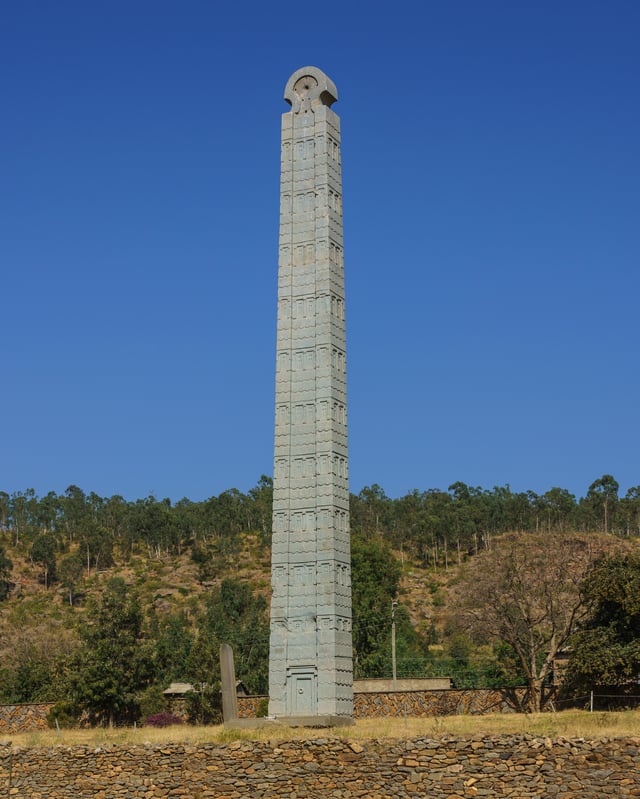
Obelisk of Aksum
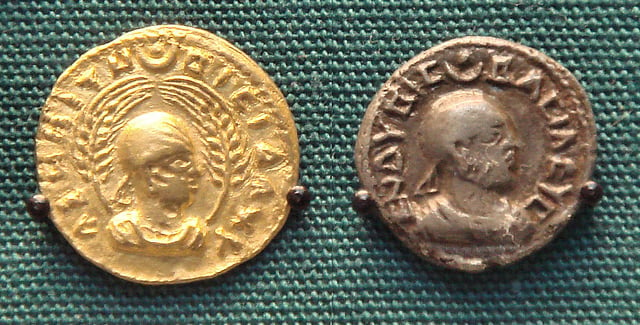
Aksumite currency of the Aksumite king Endubis, 227–35, at the British Museum. The inscriptions in Ancient Greek read "ΑΧΩΜΙΤΩ ΒΑΣΙΛΕΥΣ" ("KING OF AXUM") and "ΕΝΔΥΒΙΣ ΒΑΣΙΛΕΥΣ" ("KING ENDUBIS"), the Greek language was the lingua franca by that time so the Axumite kings used it in coins to simplify foreign trade.
Around the 8th century BC, a kingdom known as Dʿmt was established in Tigray northern Ethiopia, and Eritrea. The polity's capital was located at Yeha, in northern Ethiopia. Most modern historians consider this civilization to be a native Ethiopian one, although Sabaean-influenced because of the latter's hegemony of the Red Sea.[20]
Other scholars regard Dʿmt as the result of a union of Afroasiatic-speaking cultures of the Cushitic and Semitic branches; namely, local Agaw peoples and Sabaeans from South Arabia. However, Ge'ez, the ancient Semitic language of Ethiopia, is thought to have developed independently from Sabaean, one of the South Semitic languages. As early as 2000 BC, other Semitic speakers were living in Ethiopia and Eritrea where Ge'ez developed.[56]*Church%20and%20State%20in%20Ethio]]*ntury. It may have been a trading or military colony in alliance with the Ethiopian civilization of Dʿmt or some other proto-Aksumite state.[20]
After the fall of Dʿmt during the fourth century BC, the Ethiopian plateau came to be dominated by smaller successor kingdoms.
In the first century AD, the Kingdom of Aksum emerged in what is now Tigray and Eritrea. According to the medieval Book of Aksum, the kingdom's first capital, Mazaber, was built by Itiyopis, son of Cush.[38] Aksum would later at times extend its rule into Yemen on the other side of the Red Sea.[58] The Persian religious figure Mani listed Aksum with Rome, Persia, and China as one of the four great powers of his era, during the 3rd century.[59]
Around 316 AD, Frumentius and his brother Edesius from Tyre accompanied their uncle on a voyage to Ethiopia. When the vessel stopped at a Red Sea port, the natives killed all the travellers except the two brothers, who were taken to the court as slaves. They were given positions of trust by the monarch, and they converted members of the royal court to Christianity. Frumentius became the first bishop of Aksum.[60] A coin dated to 324 shows that Ethiopia was the second country to officially adopt Christianity (after Armenia did so in 301), although the religion may have been at first confined to court circles; it was the first major power to do so.
The weakened Axumite dynasty came to an end in the 9th century when Yodit defeated the last king of the dynasty.
Empress Yodits reign, which lasted for 40 years, aimed to abolish Christianity (a religion first accepted by King Ezana of the Axumite dynasty) by burning down churches and crucifying people who remained faithful to the orthodox Tewahedo church, which at the time was considered as the religion of the state.
The Empress tried to force many people to change their religion and destroyed much historical heritage of the Axumite dynasty earning her the epithet of Yodit Gudit (in Amharic ዮዲት ጉዲት).
Her reign finally came to an end in 912 following her defeat by the first leader of the Zagwe dynasty.[61]
The reign of the Zagwe dynasty came to an end by the rise of one of the earliest local Muslim states, the Makhzumi Sultanate established in the Shewa region. This polity was governed by the Makhzumi dynasty, which reigned over the province until it was deposed around 1280 by the Walashma dynasty.[62]
During Muhammad's era
The first interaction that the Islamic Prophet Muhammad had with Ethiopia was during the reign of Aṣḥama ibn Abjar, who was at the time the Emperor of Aksum and gave refuge to several Muslims in the Kingdom of Aksum in 614 AD.[63]Enc]][[64]](https://openlibrary.org/search?q=Hable%20Sellassie%2C%20Sergew%20%281972%29.%20%20 [[CITE|64|https://openlibrary.org/search?q=Hable%20Sellassie%2C%20Sergew%20%281972%29.%20%20*Ancient%20and%20Medi)Wiqro[56]Church%20and%20State%20in%20Ethio]]
Muhammad's second interaction with Ethiopia was during the Expedition of Zaid ibn Haritha, when he sent Amr bin Umayyah al-Damri to the King of Ethiopia (then Abyssinia).[67]
Middle Ages
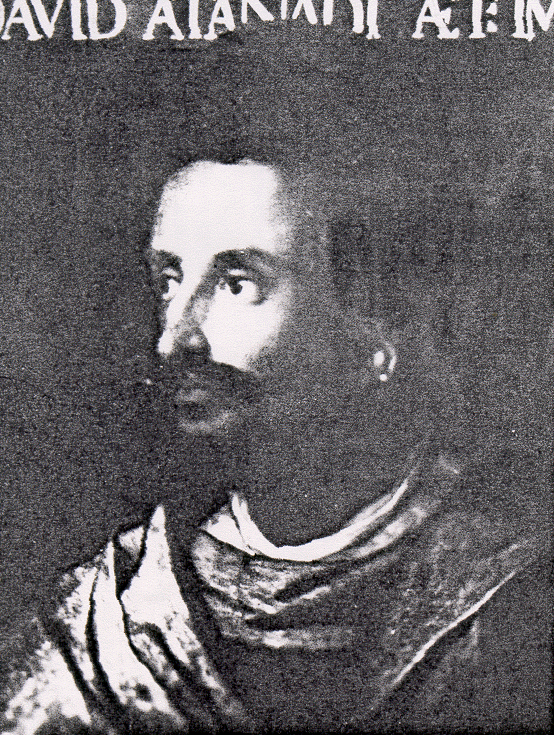
Dawit II (Lebna Dengel), Emperor of Ethiopia (r. 1507–1540) and a member of the Solomonic dynasty
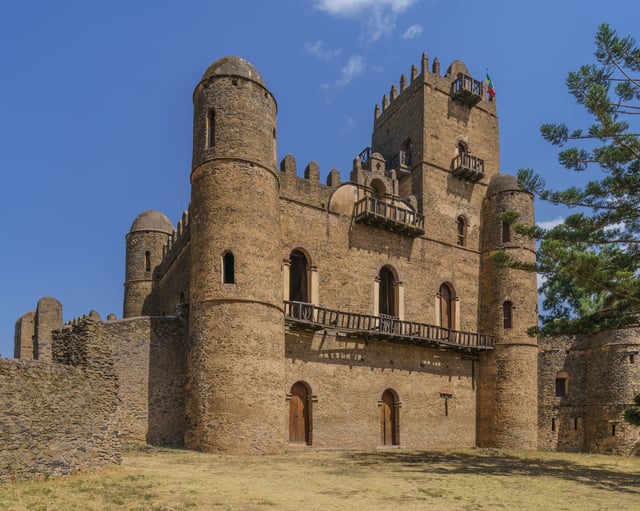
The castle of Fasilides
The Zagwe dynasty ruled many parts of present-day Ethiopia and Eritrea between the early 12th and late 13th century. The name of the dynasty is derived from the Cushitic-speaking Agaw of northern Ethiopia. From 1270 AD until the Zemene Mesafint (Age of Princes), the Solomonic dynasty governed the Ethiopian Empire.[68]
In the early 15th century, Ethiopia sought to make diplomatic contact with European kingdoms for the first time since the Aksumite era.
A letter from Henry IV of England to the Emperor of Abyssinia survives.[69] In 1428, Yeshaq I sent two emissaries to Alfonso V of Aragon, who sent return emissaries. They failed to complete the return trip.[70] The first continuous relations with a European country began in 1508 with Portugal under Dawit II (Lebna Dengel), who had just inherited the throne from his father.[71]
This proved to be an important development, for when the Empire was subjected to the attacks of the Adal Sultanate's general and imam, Ahmad ibn Ibrahim al-Ghazi (called "Grañ " "the Left-handed"), Portugal assisted the Ethiopian emperor by sending weapons and four hundred men, who helped his son Gelawdewos defeat Ahmad and re-establish his rule.[72] This Abyssinian–Adal war was also one of the first proxy wars in the region, as the Ottoman Empire and Portugal took sides in the conflict. When Emperor Susenyos I converted to Roman Catholicism in 1624, years of revolt and civil unrest followed, resulting in thousands of deaths.[73] The Jesuit missionaries had offended the Ethiopian Orthodox Tewahedo faith of the local Ethiopians. In June 1632, Fasilides, Susenyos' son, declared the state religion again to be the Ethiopian Orthodoxy. He expelled the Jesuit missionaries and other Europeans.[74][75]
Aussa Sultanate
The Sultanate of Aussa or "Afar Sultanate" succeeded the earlier Imamate of Aussa. The latter polity had come into existence in 1577 when Muhammed Jasa moved his capital from Harar to Aussa (Asaita) with the split of the Adal Sultanate into the Sultanate of Aussa and the Sultanate of Harar. At some point after 1672, the Sultanate of Aussa declined and temporarily came to an end in conjunction with Imam Umar Din bin Adam's recorded ascension to the throne.[76]
Zemene Mesafint
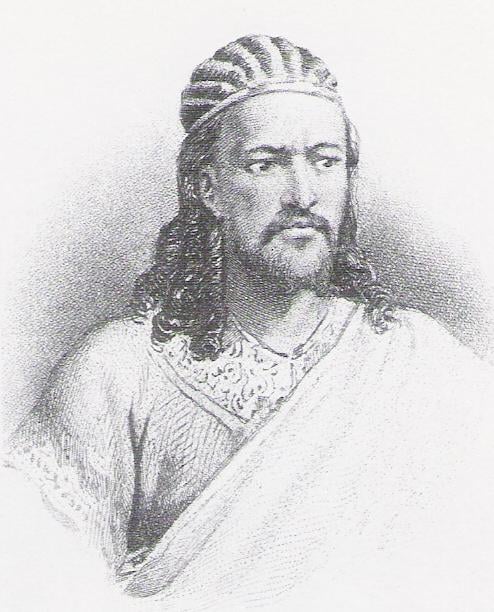
Emperor Tewodros II of Ethiopia
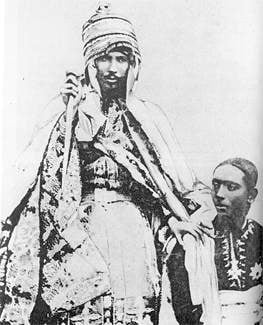
Emperor Yohannes IV led Ethiopian troops during the battles of Galabat, Gundet and Gura.
Between 1755 and 1855, Ethiopia experienced a period of isolation referred to as the Zemene Mesafint or "Age of Princes". The Emperors became figureheads, controlled by warlords like RasRas]][[79]](https://openlibrary.org/search?q=Pankhurst%2C%20Richard%2C%20 [[CITE|79|https://openlibrary.org/search?q=Pankhurst%2C%20Richard%2C%20*The%20Ethiopian%20Royal%20Chronicle)[80]
Ethiopian isolationism ended following a British mission that concluded an alliance between the two nations, but it was not until 1855 that Ethiopia was completely united and the power in the Emperor restored, beginning with the reign of Tewodros II who had been born in Begemder from a nobleman of Qwara, where the Qwara dialect of the Agaw language is spoken.
Upon his ascent, he began modernizing Ethiopia and recentralizing power in the Emperor. Ethiopia began to take part in world affairs once again.[81]
But Tewodros suffered several rebellions inside his empire.
Northern Oromo militias, Tigrayan rebellion, and the constant incursion of Ottoman Empire and Egyptian forces near the Red Sea brought the weakening and the final downfall of Tewodros II.
He killed himself in 1868 during his last fight with the British Expedition to Abyssinia at the Battle of Magdala.
After Tewodros' death, Tekle Giyorgis II was proclaimed Emperor but was defeated in the Battles of Zulawu (21 June 1871) and Adua (11 July 1871).
The victorious Mercha Kassai was subsequently declared Yohannes IV on 21 January 1872. In 1875 and 1876, Turkish/Egyptian forces, accompanied by many European and American 'advisors', twice invaded Abyssinia but were initially defeated: once at the Battle of Gundet losing 800 men, and then in the second invasion, decisively defeated by Emperor Yohannes IV at the Battle of Gura on 7 March 1875, where the invading forces lost at least 3000 men by death or captured.[82] From 1885 to 1889, Ethiopia joined the Mahdist War allied to Britain, Turkey, and Egypt against the Sudanese Mahdist State. On 10 March 1889, Yohannes IV was killed by the Sudanese Khalifah Abdullah's army whilst leading his army in the Battle of Gallabat (also called Battle of Metemma).[83]
From Menelik II to Adwa (1889–1913)
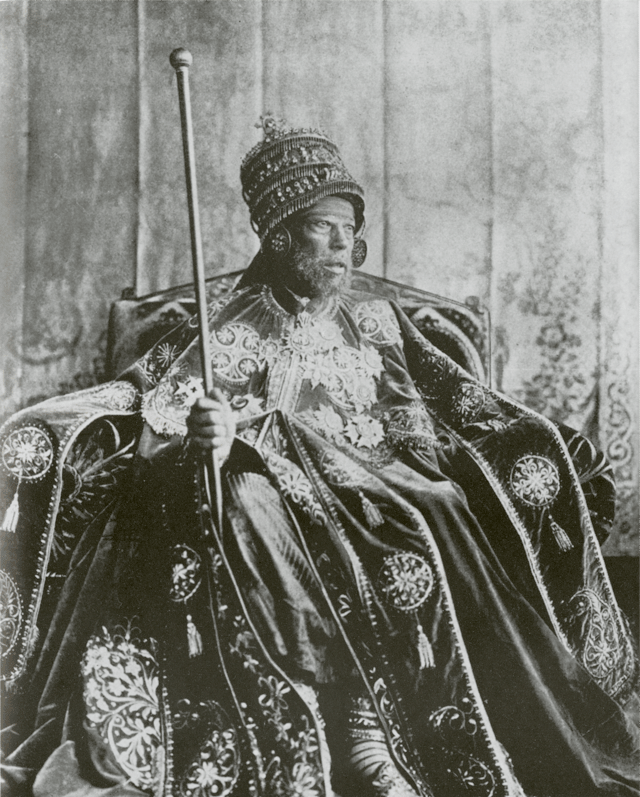
Emperor Menelik II, former Governor of Shewa
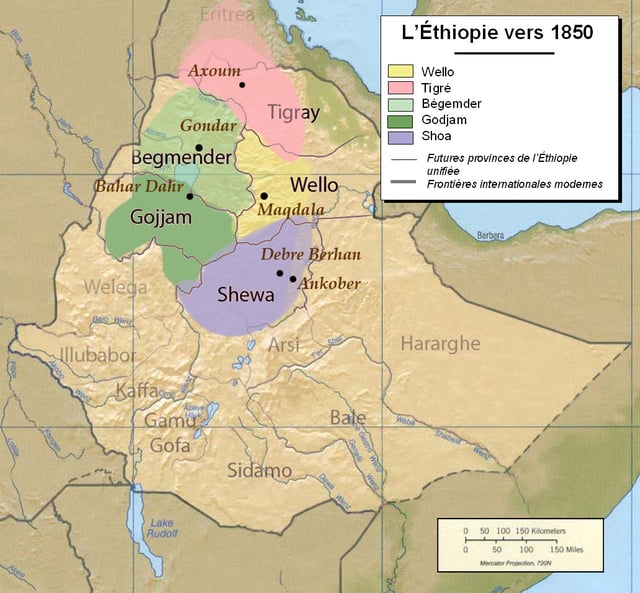
Ethiopia and other territories in Africa in 1843
Ethiopia in its roughly current form began under the reign of Menelik II, who was Emperor from 1889 until his death in 1913. From his base in the central province of Shewa, Menelik set out to annex territories to the south, east and west,[84] areas inhabited by the Oromo, Sidama, Gurage, Welayta, and other groups.[85] He did this with the help of Ras Gobana Dacche's Shewan Oromo militia, which occupied lands that had not been held since Ahmad ibn Ibrahim al-Ghazi's war, as well as other areas that had never been under Ethiopian sovereignty.[86] Menelik's campaign against Oromos outside his army was largely in retaliation for centuries of Oromo expansionism and the Zemene Mesafint, a period during which a succession of Oromo feudal rulers dominated the highlanders.[87] Chief among these was the Yejju dynasty, which included Aligaz of Yejju and his brother Ali I of Yejju. Ali I founded the town of Debre Tabor in the Amhara Region, which became the dynasty's capital.[88]
During his reign, Menelik II made advances in road construction, electricity and education; the development of a central taxation system; and the foundation and building of the city of Addis Ababa—which became capital of Shewa Province in 1881.
For his leadership, despite pushback from more traditional elements of society, Menelik II is heralded as a national hero.
After he ascended to the throne in 1889, it was renamed as Addis Ababa, the new capital of Abyssinia.
Menelik had signed the Treaty of Wichale with Italy in May 1889 in which Italy would recognize Ethiopia's sovereignty so long as Italy could control an area north of Ethiopia (part of modern Eritrea).
In return, Italy was to provide Menelik with weapons and support him as emperor.
The Italians used the time between the signing of the treaty and its ratification by the Italian government to expand their territorial claims.
This conflict erupted in the Battle of Adwa on 1 March 1896 in which Italy's colonial forces were defeated by the Ethiopians.[85][91]
Haile Selassie I era (1916–1974) and Italian Ethiopia
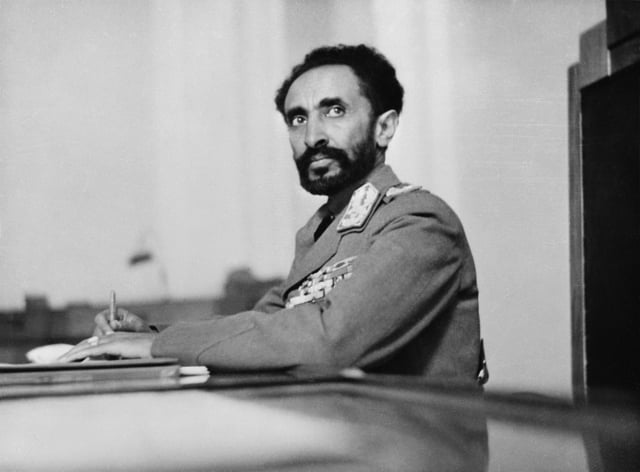
Haile Selassie at his study at the palace
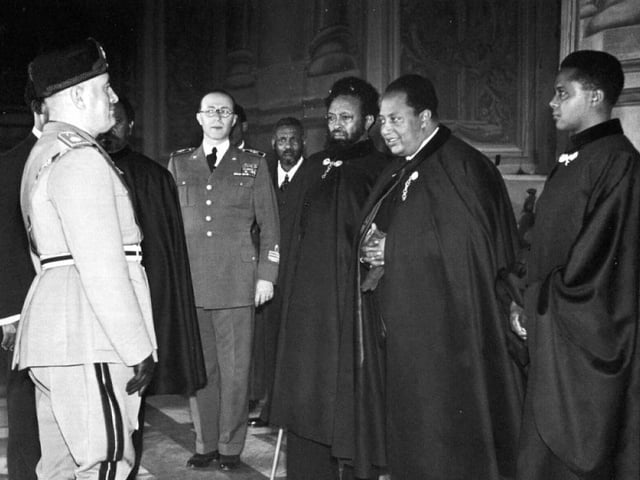
Ras Seyoum Mengesha, Ras Ghetacciù Abaté and Ras Kebbedé Guebret with Benito Mussolini on 6 February 1937 in Rome, Italy, after the Italian occupation of Ethiopia.

The 1897 Ethiopian flag with the Lion of Judah
The early 20th century was marked by the reign of Emperor Haile Selassie (Ras Tafari). Haile Selassie I was born to parents with ethnic links to three of Ethiopia's Afroasiatic-speaking populations: the Oromo and Amhara, the country's two largest ethnic groups, as well as the Gurage. He came to power after Iyasu V was deposed, and undertook a nationwide modernization campaign from 1916, when he was made a Ras and Regent (Inderase) for the Empress Regnant, Zewditu, and became the de facto ruler of the Ethiopian Empire. Following Zewditu's death, on 2 November 1930, he succeeded her as emperor.[94]
The independence of Ethiopia was interrupted by the Second Italo-Ethiopian War, beginning when it was invaded by Fascist Italy in early October 1935, and Italian occupation of the country (1936–1941).[95] During this time, Haile Selassie appealed to the League of Nations in 1935, delivering an address that made him a worldwide figure, and the 1935 Time Man of the Year.[96] As the majority of the Ethiopian population lived in rural towns, Italy faced continued resistance and ambushes in urban centres throughout its occupation. Haile Selassie fled into exile in Fairfield House, Bath and Mussolini was able to proclaim Italian Ethiopia and the assumption of the imperial title by the Italian king Vittorio Emanuele III.[97]
In 1937, the Italian massacre of Yekatit 12, in which many Ethiopians were imprisoned and massacred, took place. This was because of a failed attempt to assassinate Rodolfo Graziani, the viceroy of Italian East Africa.[98]
Following the entry of Italy into World War II, British Empire forces, together with the Arbegnoch (literally, "patriots", referring to armed resistance soldiers) restored the sovereignty of Ethiopia in the course of the East African Campaign in 1941. An Italian guerrilla warfare campaign continued until 1943. This was followed by British recognition of Ethiopia's full sovereignty, without any special British privileges, when the Anglo-Ethiopian Agreement was signed in December 1944.[99] Under the peace treaty of 1947, Italy recognised the sovereignty and independence of Ethiopia.
In 1952, Haile Selassie orchestrated a federation with Eritrea. He dissolved this in 1962 and annexed Eritrea, resulting in the Eritrean War of Independence. Haile Selassie played a leading role in the formation of the Organisation of African Unity (OAU) in 1963.[102]
Opinion within Ethiopia turned against Haile Selassie I owing to the worldwide 1973 oil crisis. This oil crisis caused a sharp increase in gasoline prices starting on 13 February 1974; food shortages; uncertainty regarding the succession; border wars; and discontent in the middle class created through modernization.[103] The high gasoline prices motivated taxi drivers and teachers to go on strike on 18 February 1974, and students and workers in Addis Ababa began demonstrating against the government on 20 February 1974.[104] The feudal oligarchical cabinet of Akilou Habte Wolde was toppled, and a new government was formed with Endelkachew Makonnen serving as Prime Minister.[105]
Communist era (1974–1991)
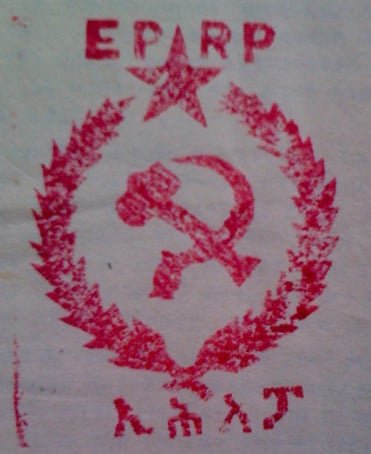
The Ethiopian People's Revolutionary Party (EPRP) clashed with the Derg during the Qey Shibir
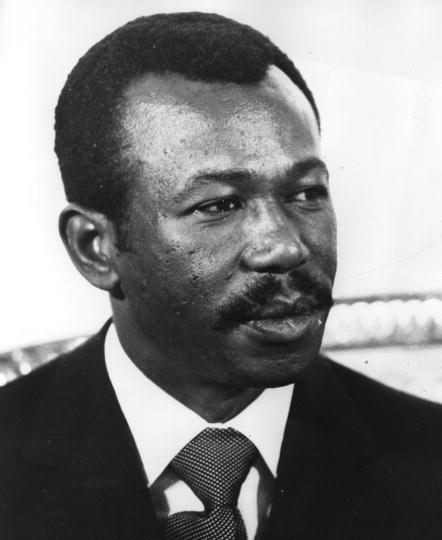
Ethiopian dictator Mengistu Haile Mariam (in office 1977–1991) was sentenced to death in Ethiopia for crimes committed during his government. As of 2018, he lived in exile in Zimbabwe.[114]
The ensuing government suffered several coups, uprisings, wide-scale drought, and a huge refugee problem.
In 1977, Somalia, which had previously been receiving assistance and arms from the USSR, invaded Ethiopia in the Ogaden War, capturing part of the Ogaden region. Ethiopia recovered it after it began receiving massive military aid from the USSR, Cuba, South Yemen, East Germany,[108] and North Korea. This included around 15,000 Cuban combat troops.[109][110]
In 1977–78, up to 500,000 were killed as a result of the Red Terror,[111] from forced deportations or from the use of hunger as a weapon under Mengistu's rule.[103] The Red Terror was carried out in response to what the Derg termed the 'White Terror', a chain of violent events, assassinations, and killings carried out by what it called "petty bourgeois reactionaries" who desired a reversal of the 1974 revolution.[112][113]
The 1983–85 famine in Ethiopia affected around eight million people, resulting in one million dead. Insurrections against Communist rule sprang up, particularly in the northern regions of Eritrea and Tigray. The Tigrayan People's Liberation Front (TPLF) merged with other ethnically-based opposition movements in 1989, to form the coalition known as the Ethiopian People's Revolutionary Democratic Front (EPRDF).[115]
Concurrently, the Soviet Union began to retreat from building world communism under Mikhail Gorbachev's glasnost and perestroika policies, marking a dramatic reduction in aid to Ethiopia from Socialist Bloc countries. This resulted in more economic hardship and the collapse of the military in the face of determined onslaughts by guerrilla forces in the north. The collapse of Marxism–Leninism in general, and in eastern Europe during the revolutions of 1989, coincided with the Soviet Union stopping aid to Ethiopia altogether in 1990. The strategic outlook for Mengistu quickly deteriorated.[116][117]
In 2006, after a trial that lasted 12 years, Ethiopia's Federal High Court in Addis Ababa found Mengistu guilty of genocide in absentia.[120] Numerous other top leaders of his government were also found guilty of war crimes. Mengistu and others who had fled the country were tried and sentenced in absentia. Numerous former officials received the death sentence and tens of others spent the next 20 years in jail, before being pardoned from life sentences.[121][122][123][124]
In July 1991, EPRDF convened a National Conference to establish the Transitional Government of Ethiopia composed of an 87-member Council of Representatives and guided by a national charter that functioned as a transitional constitution.[125] In June 1992, the Oromo Liberation Front withdrew from the government; in March 1993, members of the Southern Ethiopia Peoples' Democratic Coalition also left the government.[126][127] In 1994, a new constitution was written that established a parliamentary republic with a bicameral legislature and a judicial system.[1]
Federal Democratic Republic (1991–present)
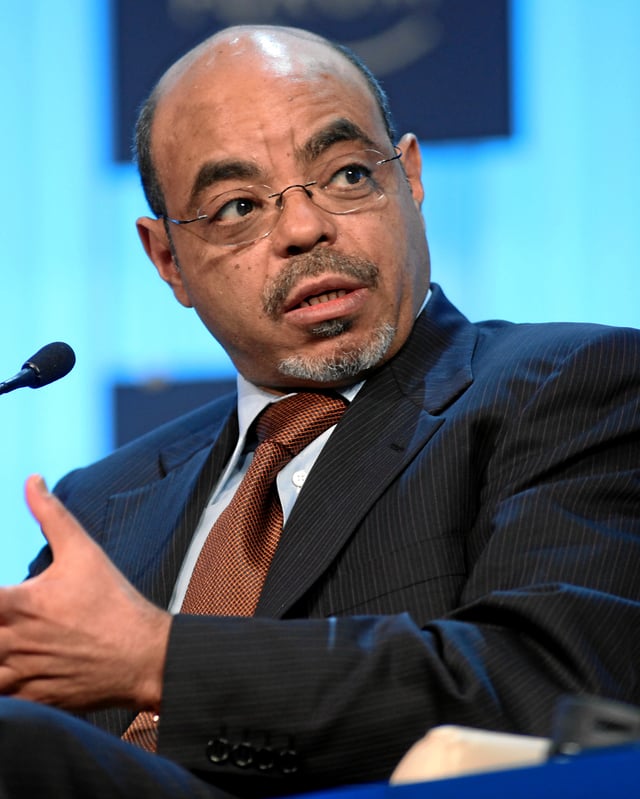
Former Prime Minister Meles Zenawi at the 2012 World Economic Forum annual meeting
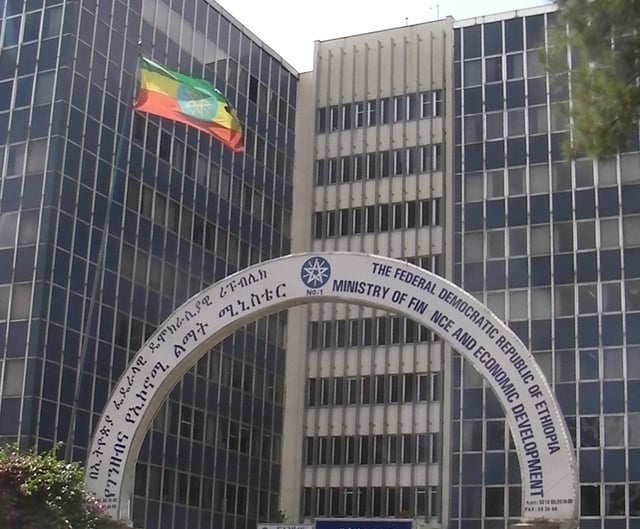
The Ministry of Finance and Economic Development headquarters

Former Prime Minister of Ethiopia Hailemariam Desalegn meeting with former US Deputy Secretary of Defense Ash Carter in Addis Ababa.
Ethiopia's 3rd multiparty election on 15 May 2005 was highly disputed, with some opposition groups claiming fraud. Though the Carter Center approved the pre-election conditions, it expressed its dissatisfaction with post-election events. European Union election observers cited state support for the EPRDF campaign, as well as irregularities in ballot counting and results publishing.[132] The opposition parties gained more than 200 parliamentary seats, compared with just 12 in the 2000 elections. While most of the opposition representatives joined the parliament, some leaders of the CUD party who refused to take up their parliamentary seats were accused of inciting the post-election violence and were imprisoned. Amnesty International considered them "prisoners of conscience" and they were subsequently released.[133]
A coalition of opposition parties and some individuals was established in 2009 to oust the government of the EPRDF in legislative elections of 2010. Meles' party, which has been in power since 1991, published its 65-page manifesto in Addis Ababa on 10 October 2009. The opposition won most votes in Addis Ababa, but the EPRDF halted counting of votes for several days. After it ensued, it claimed the election, amidst charges of fraud and intimidation.[134]
Some of the eight member parties of the Medrek (Forum for Democratic Dialogue) include the Oromo Federalist Congress (organized by the Oromo Federalist Democratic Movement and the Oromo People's Congress), the Arena Tigray (organized by former members of the ruling party TPLF), the Unity for Democracy and Justice (UDJ, whose leader is imprisoned), and the Coalition of Somali Democratic Forces.
In mid-2011, two consecutively missed rainy seasons precipitated the worst drought in East Africa seen in 60 years. Full recovery from the drought's effects did not occur until 2012, with long-term strategies by the national government in conjunction with development agencies believed to offer the most sustainable results.[135]
Meles died on 20 August 2012 in Brussels, where he was being treated for an unspecified illness.[136] Deputy Prime Minister Hailemariam Desalegn was appointed as a new prime minister until the 2015 elections,[137] and remained so afterwards with his party in control of every parliamentary seat.[138]
Protests broke out across the country on 5 August 2016 and dozens of protesters were subsequently shot and killed by police. The protesters demanded an end to human rights abuses, the release of political prisoners, a fairer redistribution of the wealth generated by over a decade of economic growth, and a return of Wolqayt District to the Amhara Region.[139][140][141] The events were the most violent crackdown against protesters in Sub-Saharan Africa since the Ethiopian government killed at least 75 people during protests in the Oromia Region in November and December 2015.[142][143] Following these protests, Ethiopia declared a state of emergency on 6 October 2016.[144] The state of emergency was lifted in August 2017.[145]
On 16 February 2018, the government of Ethiopia declared a six-month nationwide state of emergency following the resignation of Prime Minister Hailemariam Desalegn.[146] Hailemariam is the first ruler in modern Ethiopian history to step down; previous leaders have died in office or been overthrown.[147] He said he wanted to clear the way for reforms.
Government reforms (2018–present)
The new Prime Minister was Abiy Ahmed, who made a historic visit to Eritrea in 2018, ending the state of conflict between the countries.[148] Since taking office in April 2018, 42-year-old Abiy has also released political prisoners, promised fair elections for 2019 and announced sweeping economic reforms.[149] As of 6 June 2019, all of the previously censored websites were made accessible again, over a thousand political prisoners were released and hundreds of administrative staff were fired as part of the reforms.[150][151][152][153]
Ethnic violence rose with the political unrest. There were Oromo–Somali clashes between the Oromo, who make up the largest ethnic group in the country, and the ethnic Somalis, leading to up to 400,000 have been displaced in 2017.[154] Gedeo–Oromo clashes between the Oromo and the Gedeo people in the south of the country led to Ethiopia having the largest number of people to flee their homes in the world in 2018, with 1.4 million newly displaced people.[155] In September 2018 in the minorities protest that took place in Oromo near the Ethiopian capital Addis Ababa, 23 people were killed.[156] Some have blamed the rise in ethnic violence by the Oromo on the new Oromo Prime Minister Abiy Ahmed for giving space to groups formerly banned by previous Tigrayan led governments, such as the Oromo Liberation Front.[157]
Politics

The current reformist Prime Minister of Ethiopia Abiy Ahmed Ali
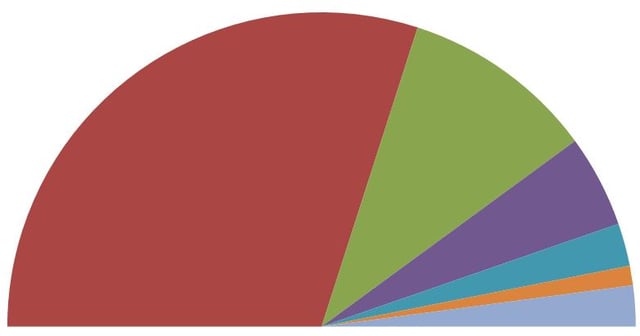
Ethiopian general election, 2005. Only parties with more than 10 seats shown.Red: EPRDF Green: CUD Purple: UEDF Dark blue: SPDP Orange: OFDM Light blue: Others
The politics of Ethiopia takes place in a framework of a federal parliamentary republic, wherein the Prime Minister is the head of government.
The President is the head of state but with largely ceremonial powers. Executive power is exercised by the government. Federal legislative power is vested in both the government and the two chambers of parliament. On the basis of Article 78 of the 1994 Ethiopian Constitution, the Judiciary is completely independent of the executive and the legislature.[158] In 2015, the realities of this provision were questioned in a report prepared by Freedom House.[159]
According to the Democracy Index published by the United Kingdom-based Economist Intelligence Unit in late 2010, Ethiopia was an "authoritarian regime", ranking as the 118th-most democratic out of 167 countries.[160] Ethiopia had dropped 12 places on the list since 2006, and the 2010 report attributed the drop to the government's crackdown on opposition activities, media and civil society before the 2010 parliamentary election, which the report argued had made Ethiopia a de facto one-party state.
However, since the appointment of Abiy Ahmed as prime minister in 2018, the situation has rapidly evolved.
In July 2015, during a trip that then-U.S.
President Barack Obama took to Ethiopia, he highlighted the role of the country in the fight against Islamic terrorism.[161] Obama was the first sitting United States president to visit Ethiopia.
Governance

Addis Ababa's city hall

Former Foreign Minister of Ethiopia Tedros Adhanom with former U.S. Secretary of State John Kerry
The election of Ethiopia's 547-member constituent assembly was held in June 1994.
This assembly adopted the constitution of the Federal Democratic Republic of Ethiopia in December 1994. The elections for Ethiopia's first popularly chosen national parliament and regional legislatures were held in May and June 1995. Most opposition parties chose to boycott these elections. There was a landslide victory for the Ethiopian People's Revolutionary Democratic Front (EPRDF). International and non-governmental observers concluded that opposition parties would have been able to participate had they chosen to do so.
The current government of Ethiopia was installed in August 1995.
The first President was Negasso Gidada. The EPRDF-led government of Prime Minister Meles Zenawi promoted a policy of ethnic federalism, devolving significant powers to regional, ethnically based authorities. Ethiopia today has nine semi-autonomous administrative regions that have the power to raise and spend their own revenues. Under the present government, some fundamental freedoms, including freedom of the press, are circumscribed.[162]
Citizens have little access to media other than the state-owned networks, and most private newspapers struggle to remain open and suffer periodic harassment from the government.[162] Since the 2005 elections, at least 18 journalists who had written articles critical of the government, were arrested on genocide and treason charges.
The government uses press laws governing libel to intimidate journalists who are critical of its policies.[163]
Meles' government was elected in 2000 in Ethiopia's first-ever multiparty elections; however, the results were heavily criticized by international observers and denounced by the opposition as fraudulent.
The EPRDF also won the 2005 election returning Meles to power.
Although the opposition vote increased in the election, both the opposition and observers from the European Union and elsewhere stated that the vote did not meet international standards for fair and free elections.[162] Ethiopian police are said to have massacred 193 protesters, mostly in the capital Addis Ababa, in the violence following the May 2005 elections in the Ethiopian police massacre.[164]
The government initiated a crackdown in the provinces as well; in Oromia state the authorities used concerns over insurgency and terrorism to use torture, imprisonment, and other repressive methods to silence critics following the election, particularly people sympathetic to the registered opposition party Oromo National Congress (ONC).[163] The government has been engaged in a conflict with rebels in the Ogaden region since 2007. The biggest opposition party in 2005 was the Coalition for Unity and Democracy (CUD). After various internal divisions, most of the CUD party leaders have established the new Unity for Democracy and Justice party led by Judge Birtukan Mideksa. A member of the country's Oromo ethnic group, Ms. Birtukan Mideksa is the first woman to lead a political party in Ethiopia.
In 2008, the top five opposition parties were the Unity for Democracy and Justice led by Judge Birtukan Mideksa, United Ethiopian Democratic Forces led by Dr. Beyene Petros, Oromo Federalist Democratic Movement led by Dr. Bulcha Demeksa, Oromo People's Congress led by Dr. Merera Gudina, and United Ethiopian Democratic Party – Medhin Party led by Lidetu Ayalew. After the 2015 elections, Ethiopia lost its single remaining opposition MP;[165] there are now no opposition MPs in the Ethiopian parliament.[166]
Human rights

Karo people in the Southern Nations, Nationalities, and Peoples' Region
Recent human rights violations include the killing of 100 peaceful protestors by direct government gunfire in the Oromo and Amhara regions in 2016.[167] The UN has called for UN observers on the ground in Ethiopia to investigate this incident,[168] however the EPRDF-dominated Ethiopian government has refused this call.[169] The protestors are protesting land grabs and lack of basic human rights such as the freedom to elect their representatives. The TPLF-dominated EPRDF won 100% in an election marked by fraud which has resulted in Ethiopian civilians protesting on scale unseen in prior post-election protests.[170]
Merera Gudina, leader of the Oromo People's Congress, said the East African country was at a "crossroads".
"People are demanding their rights," he said.
"People are fed up with what the regime has been doing for a quarter of a century.
They're protesting against land grabs, reparations, stolen elections, the rising cost of living, many things.
"If the government continue to repress while the people are demanding their rights in the millions that (civil war) is one of the likely scenarios," Merera said in an interview with Reuters.[170]
According to surveys in 2003 by the National Committee on Traditional Practices in Ethiopia, marriage by abduction accounts for 69% of the nation's marriages, with around 80% in the largest region, Oromiya, and as high as 92% in the Southern Nations, Nationalities, and Peoples' Region.[171][172] Homosexual acts are illegal in Ethiopia.[173]
Among the Omotic Karo-speaking and Hamer peoples in southern Ethiopia, adults and children with physical abnormalities are considered to be mingi, "ritually impure". The latter are believed to exert an evil influence upon others; disabled infants have traditionally been murdered without a proper burial.[174] The Karo officially banned the practice in July 2012.[175]
In 2013, the Oakland Institute released a report accusing the Ethiopian government of forcing the relocation of "hundreds of thousands of indigenous people from their lands" in the Gambela Region[176] The report describes the Ethiopian government's "plans to move over 1.5 million people" by the end of 2013, in order to allow foreign investors to develop the land for large scale industrial agriculture.[176] According to several reports by the organization, those who refused were the subject of a variety of intimidation techniques including physical and sexual abuse, which sometimes led to deaths.[177][178][179] A similar 2012 report by Human Rights Watch also describes the Ethiopian government's 2010–2011 villagization program in Gambella, with plans to carry out similar resettlements in other regions.[180] The Ethiopian government has denied the accusations of land grabbing and instead pointed to the positive trajectory of the countries economy as evidence of the development program's benefits.[179]
Military
Since 1996, landlocked Ethiopia has had no navy and the army is relatively small with about 170,000 volunteers on active duty.
In 2018 Prime Minister Abiy Ahmed said on state TV: "We built one of the strongest ground and air force in Africa... we should build our naval force capacity in the future."[181]
Administrative divisions

A map of Ethiopia's regions and zones
Before 1996, Ethiopia was divided into thirteen provinces, many derived from historical regions. The nation now has a tiered governmental system consisting of a federal government overseeing ethnically based regional states, zones, districts (woreda), and kebeles
Since 1996, Ethiopia has been divided into nine ethnically-based and politically autonomous regional states (kililoch, singular kilil ) and two chartered cities (astedader akababiwoch, singular astedader akababi ), the latter being Addis Ababa and Dire Dawa. The kililoch are subdivided into sixty-eight zones, and then further into 550 woredas and several special woredas.
The constitution assigns extensive power to regional states, which can establish their own government and democracy as long as it is in line with the federal government's constitution.
Each region has at its apex a regional council where members are directly elected to represent the districts and the council has legislative and executive power to direct internal affairs of the regions.
Article 39 of the Ethiopian Constitution further gives every regional state the right to secede from Ethiopia.
There is debate, however, as to how much of the power guaranteed in the constitution is actually given to the states.
The councils implement their mandate through an executive committee and regional sectoral bureaus.
Such elaborate structure of council, executive, and sectoral public institutions is replicated to the next level (woreda).
| Region or city (ክልል/የከተማ አስተዳድር) | Capital | Area(km2) | Population[182] | ||||
|---|---|---|---|---|---|---|---|
| Oct 1994 census | May 2007 census | Jul 2012 estimate | 2017 Estimate[183] | ||||
| Addis Ababa(አዲስ አበባ) | astedader | Addis Ababa | 526.99 | 2,100,031 | 2,738,248 | 3,041,002 | 3,433,999 |
| Afar(ዓፋር) | kilil | Semera | 72,052.78 | 1,051,641 | 1,411,092 | 1,602,995 | 1,812,002 |
| Amhara(አማራ) | kilil | Bahir Dar | 154,708.96 | 13,270,898 | 17,214,056 | 18,866,002 | 21,134,988 |
| Benishangul-Gumuz(ቤ/ጉሙዝ) | kilil | Asosa | 50,698.68 | 460,325 | 670,847 | 982,004 | 1,066,001 |
| Dire Dawa(ድሬዳዋ) | astedader | Dire Dawa | 1,558.61 | 248,549 | 342,827 | 387,000 | 466,000 |
| Gambela(ጋምቤላ) | kilil | Gambela | 29,782.82 | 162,271 | 306,916 | 385,997 | 435,999 |
| Harari(ሐረሪ) | kilil | Harar | 333.94 | 130,691 | 183,344 | 210,000 | 246,000 |
| Oromia(ኦሮምያ) | kilil | Addis Ababa | 284,538.00 | 18,465,449 | 27,158,471 | 31,294,992 | 35,467,001 |
| Somali(ሶማሌ) | kilil | Jijiga | 279,252.00 | 3,144,963 | 4,439,147 | 5,148,989 | 5,748,998 |
| Southern Nations, Nationalities, and Peoples(ደቡብ ብ/ብ/ሕ) | kilil | Awasa | 105,887.18 | 10,377,028 | 15,042,531 | 17,359,008 | 19,170,007 |
| Tigray(ትግራይ) | kilil | Mek'ele | 41,410 | 3,134,470 | 4,314,456 | 4,929,999 | 5,247,005 |
| Special enumerated zones | 96,570 | 112,999 | 123,001 | ||||
| Totals | 1,127,127.00 | 51,766,239 | 73,918,505 | 84,320,987 | 94,351,001 | ||
Geography

Köppen climate classification of Ethiopia
The major portion of Ethiopia lies in the Horn of Africa, which is the easternmost part of the African landmass. The territories that have frontiers with Ethiopia are Eritrea to the north and then, moving in a clockwise direction, Djibouti, the de facto state of Somaliland, Somalia, Kenya, South Sudan and Sudan. Within Ethiopia is a vast highland complex of mountains and dissected plateaus divided by the Great Rift Valley, which runs generally southwest to northeast and is surrounded by lowlands, steppes, or semi-desert. There is a great diversity of terrain with wide variations in climate, soils, natural vegetation and settlement patterns.
Ethiopia is an ecologically diverse country, ranging from the deserts along the eastern border to the tropical forests in the south to extensive Afromontane in the northern and southwestern parts. Lake Tana in the north is the source of the Blue Nile. It also has a large number of endemic species, notably the gelada, the walia ibex and the Ethiopian wolf ("Simien fox"). The wide range of altitude has given the country a variety of ecologically distinct areas, and this has helped to encourage the evolution of endemic species in ecological isolation.
Climate
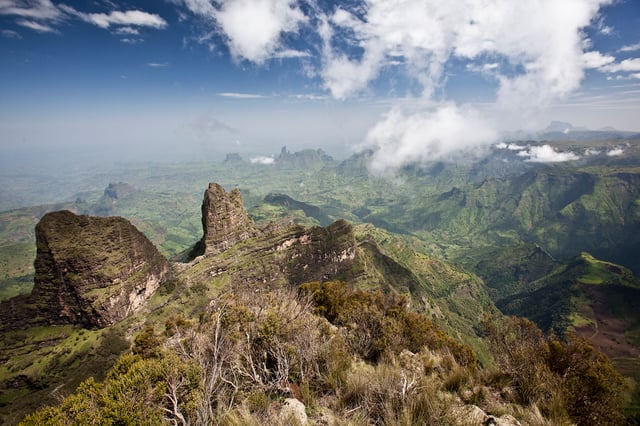
Semien Mountains
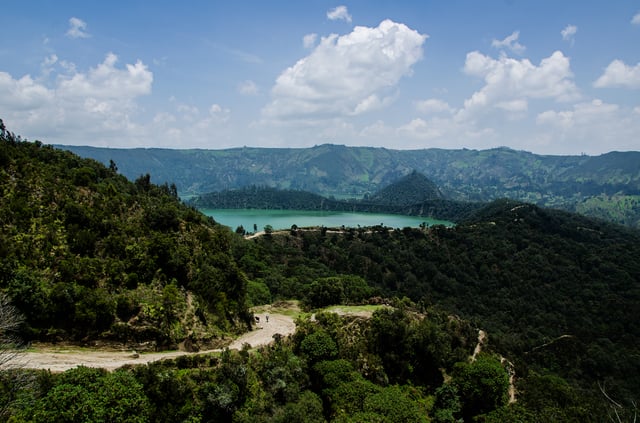
Wonchi Lake
The predominant climate type is tropical monsoon, with wide topographic-induced variation.
The Ethiopian Highlands cover most of the country and have a climate which is generally considerably cooler than other regions at similar proximity to the Equator. Most of the country's major cities are located at elevations of around 2,000–2,500 m (6,562–8,202 ft) above sea level, including historic capitals such as Gondar and Axum.
The modern capital, Addis Ababa, is situated on the foothills of Mount Entoto at an elevation of around 2,400 metres (7,900 ft). It experiences a mild climate year round. With temperatures fairly uniform year round, the seasons in Addis Ababa are largely defined by rainfall: a dry season from October to February, a light rainy season from March to May, and a heavy rainy season from June to September. The average annual rainfall is approximately 1,200 millimetres (47 in).
There are on average 7 hours of sunshine per day.
The dry season is the sunniest time of the year, though even at the height of the rainy season in July and August there are still usually several hours per day of bright sunshine.
The average annual temperature in Addis Ababa is 16 °C (60.8 °F), with daily maximum temperatures averaging 20–25 °C (68.0–77.0 °F) throughout the year, and overnight lows averaging 5–10 °C (41.0–50.0 °F).
Most major cities and tourist sites in Ethiopia lie at a similar elevation to Addis Ababa and have a comparable climate.
In less elevated regions, particularly the lower lying Ethiopian xeric grasslands and shrublands in the east of the country, the climate can be significantly hotter and drier. Dallol, in the Danakil Depression in this eastern zone, has the world's highest average annual temperature of 34 °C (93.2 °F).
Environment
Wildlife
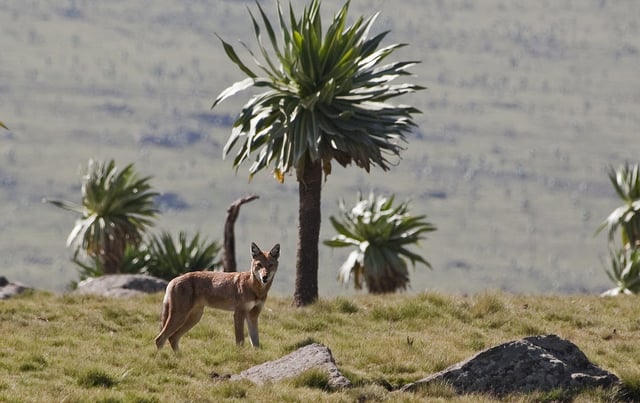
The Ethiopian wolf

A Swallowtail butterfly at Lake Tana
Ethiopia has 31 endemic species of mammals.[184] The African wild dog prehistorically had widespread distribution in the territory. However, with last sightings at Finicha'a, this canid is thought to be potentially locally extinct. The Ethiopian wolf is perhaps the most researched of all the endangered species within Ethiopia.
Ethiopia is a global center of avian diversity.
To date more than 856 bird species have been recorded in Ethiopia, twenty of which are endemic to the country.[185] Sixteen species are endangered or critically endangered.
A large number of these birds feed on butterflies, like the Bicyclus anynana.[186]
Historically, throughout the African continent, wildlife populations have been rapidly declining due to logging, civil wars, pollution, poaching, and other human factors.[187] A 17-year-long civil war, along with severe drought, negatively impacted Ethiopia's environmental conditions, leading to even greater habitat degradation.[188] Habitat destruction is a factor that leads to endangerment. When changes to a habitat occur rapidly, animals do not have time to adjust. Human impact threatens many species, with greater threats expected as a result of climate change induced by greenhouse gases.[189] With carbon dioxide emissions in 2010 of 6,494,000 tonnes, Ethiopia contributes just 0.02% to the annual human-caused release of greenhouse gases.[190]
Ethiopia has a large number of species listed as critically endangered, endangered, and vulnerable to global extinction.
The threatened species in Ethiopia can be broken down into three categories (based on IUCN ratings): critically endangered, endangered, and vulnerable.[184]
| Critically endangered mammals[191] | Endangered mammals | Vulnerable mammals | ||
|---|---|---|---|---|
| Cushioned gerbil | Grévy's zebra | African elephant | Large-eared free-tailed bat | Red-fronted gazelle |
| Black rhinoceros | Mountain nyala | Ammodile | Lesser horseshoe bat | Rupp's mouse |
| Ethiopian wolf | Nubian ibex | Bailey's shrew | Lion | Scott's mouse-eared bat |
| Guramba shrew | African wild dog | Bale shrew | Lucina's shrew | Soemmerring's gazelle |
| Harenna shrew | Beira antelope | Morris's bat | Speke's gazelle | |
| MacMillan's shrew | Cheetah | Mouse-tailed bat | Spotted-necked otter | |
| Walia ibex | Dibatag | Natal free-tailed bat | Ethiopian striped mouse | |
| Dorcas gazelle | Nikolaus's mouse | |||
| Glass's shrew | Patrizi's trident leaf-nosed bat | |||
Deforestation
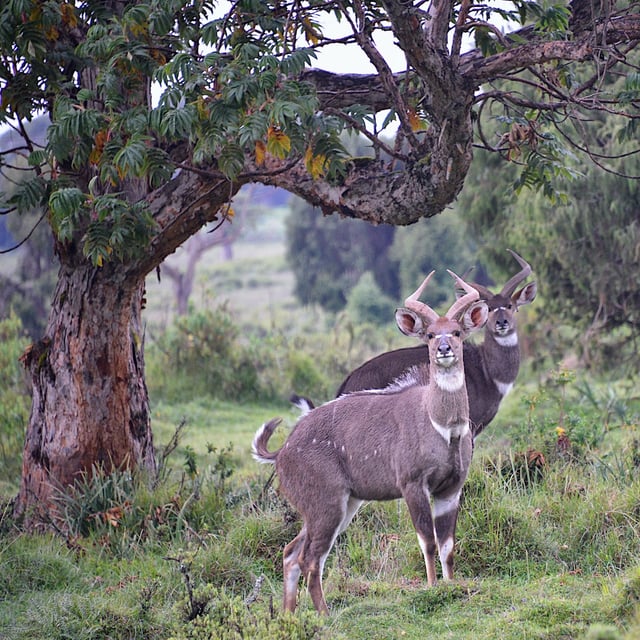
Mountain nyalas in Bale Mountains National Park, one of several wildlife reserves in Ethiopia
Ethiopia is one of the eight fundamental and independent centers of origin for cultivated plants in the world.[192] However, deforestation is a major concern for Ethiopia as studies suggest loss of forest contributes to soil erosion, loss of nutrients in the soil, loss of animal habitats, and reduction in biodiversity.
At the beginning of the 20th century, around 420,000 km2 (or 35%) of Ethiopia's land was covered by trees, but recent research indicates that forest cover is now approximately 11.9% of the area.[193]
Ethiopia loses an estimated 1,410 km2 of natural forests each year.
Between 1990 and 2005 the country lost approximately 21,000 km2 of forests.
Current government programs to control deforestation consist of education, promoting reforestation programs, and providing raw materials which are alternatives to timber.
In rural areas the government also provides non-timber fuel sources and access to non-forested land to promote agriculture without destroying forest habitat.
Organizations such as SOS and Farm Africa are working with the federal government and local governments to create a system of forest management.[195] Working with a grant of approximately 2.3 million Euros, the Ethiopian government recently began training people on reducing erosion and using proper irrigation techniques that do not contribute to deforestation.
This project is assisting more than 80 communities.
Protection
Since April 2019, Ethiopian prime minister, Abiy Ahmed has promoted Beautifying Sheger, a development project that aims to reduce the negative effects of climate change – among other things – in the capital city of Addis Ababa.[196] In the following May, the government held "Dine for Sheger", a fundraising event in order to cover some of the $1 billion needed through the public.[197] $25 million was raised through the expensive event, both through the cost of attending and donation.[198] Two Chinese railway companies under the Belt and Road Initiative between China and Ethiopia had supplied funds to develop 12 of the total 56 kilometres.[199]
Economy
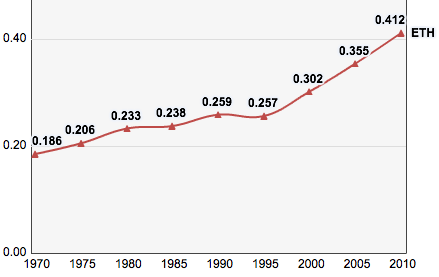
Ethiopia's Human Development Index rating 1970–2010
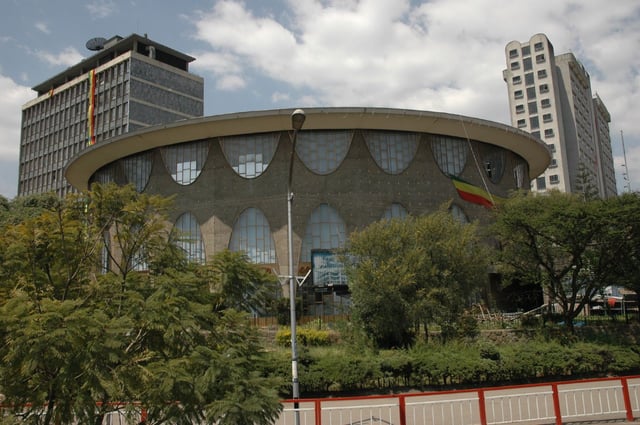
The Commercial Bank of Ethiopia in Addis Ababa
| Share of world GDP (PPP)[200] | |
|---|---|
| Year | Share |
| 1980 | 0.08% |
| 1990 | 0.07% |
| 2000 | 0.07% |
| 2010 | 0.10% |
| 2017 | 0.16% |
According to the IMF, Ethiopia was one of the fastest growing economies in the world, registering over 10% economic growth from 2004 through 2009.[201] It was the fastest-growing non-oil-dependent African economy in the years 2007 and 2008.[202] In 2015, the World Bank highlighted that Ethiopia had witnessed rapid economic growth with real domestic product (GDP) growth averaging 10.9% between 2004 and 2014.[203]
In 2008 and 2011, Ethiopia's growth performance and considerable development gains were challenged by high inflation and a difficult balance of payments situation. Inflation surged to 40% in August 2011 because of loose monetary policy, large civil service wage increase in early 2011, and high food prices.[204] For 2011/12, end-year inflation was projected to be about 22%, and single digit inflation is projected in 2012/13 with the implementation of tight monetary and fiscal policies.[205]
In spite of fast growth in recent years, GDP per capita is one of the lowest in the world, and the economy faces a number of serious structural problems.
However, with a focused investment in public infrastructure and industrial parks, Ethiopia's economy is addressing its structural problems to become a hub for light manufacturing in Africa.[206] In 2019 a law was passed allowing expatriate Ethiopians to invest in Ethiopia's financial service industry.[207]
The Ethiopian constitution defines the right to own land as belonging only to "the state and the people", but citizens may lease land (up to 99 years), and are unable to mortgage or sell. Renting of land for a maximum of twenty years is allowed and this is expected to ensure that land goes to the most productive user. Land distribution and administration is considered an area where corruption is institutionalized, and facilitation payments as well as bribes are often demanded when dealing with land-related issues.[208] As there is no land ownership, infrastructural projects are most often simply done without asking the land users, which then end up being displaced and without home or land. A lot of anger and distrust sometimes results in public protests. In addition, agricultural productivity remains low, and frequent droughts still beset the country, also leading to internal displacement.[209]
Energy and hydropower
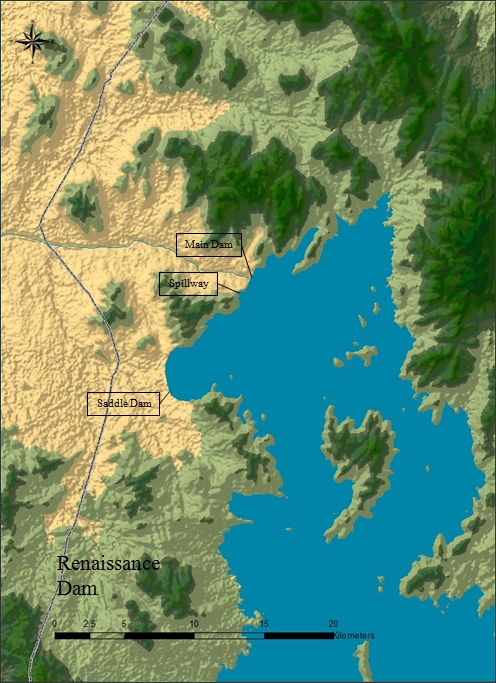
Layout of the Grand Renaissance Dam.
Ethiopia has 14 major rivers, which flow from its highlands, including the Nile. The country has the largest water reserves in Africa. As of 2012, hydroelectric plants represented around 88.2% of the total installed electricity capacity. The remaining electrical power was generated from fossil fuels (8.3%) and other renewable sources (3.6%). The electrification rate for the total population in 2013 was 24%, with 85% coverage in urban areas and 10% coverage in rural areas. As of 2014, total electricity production was 9.5 billion kWh and consumption was 6.7 billion kWh. There were 1.1 billion kWh in electricity exports, 0 kWh in electricity imports, and 2.4 million kW of installed generating capacity.[3]
Ethiopia delivers roughly 81% of water volume to the Nile through the river basins of the Blue Nile, Sobat River and Atbara. In 1959, Egypt and Sudan signed a bilateral treaty, the 1959 Nile Waters Agreement, which gave both countries exclusive maritime rights over the Nile waters. Ever since, Egypt was under international law they voted that almost all projects in Ethiopia that sought to utilize the local Nile tributaries. This had the effect of discouraging external financing of hydropower and irrigation projects in western Ethiopia, thereby impeding water resource-based economic development projects. However, Ethiopia is in the process of constructing a large 6,450 MW hydroelectric dam on the Blue Nile river. When completed, this Grand Ethiopian Renaissance Dam is slated to be the largest hydroelectric power station on the continent.[210] The Gibe III hydroelectric project so far the largest in the country, has installed capacity of 1,870-MW. For year 2017-18 (2010 E.C) the hydro electric dam generated 4,900 GWH. [211]
Agriculture
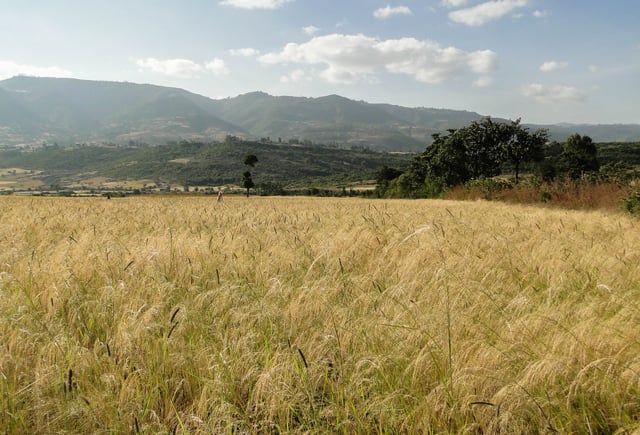
Tef field near Mojo
Agriculture constitutes around 85% of the labour force.
However, the service sector represents the largest portion of the GDP.[3] Many other economic activities depend on agriculture, including marketing, processing, and export of agricultural products. Production is overwhelmingly by small-scale farmers and enterprises, and a large part of commodity exports are provided by the small agricultural cash-crop sector. Principal crops include coffee, legumes, oilseeds, cereals, potatoes, sugarcane, and vegetables. Ethiopia is also a Vavilov center of diversity for domesticated crops, including enset,[212] coffee and teff.
Exports are almost entirely agricultural commodities (with the exception of Gold exports), and coffee is the largest foreign exchange earner. Ethiopia is Africa's second biggest maize producer.[213] According to UN estimations the per capita GDP of Ethiopia has reached $357 as of 2011.[214] The same report indicated that the life expectancy had improved substantially in recent years. The life expectancy of men is reported to be 56 years and for women 60 years.
Exports
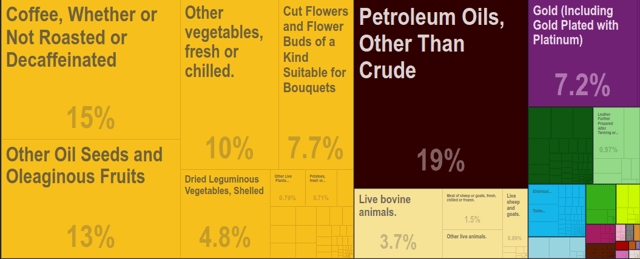
Ethiopia Export Treemap from MIT–Harvard Economic Complexity Observatory (2014)
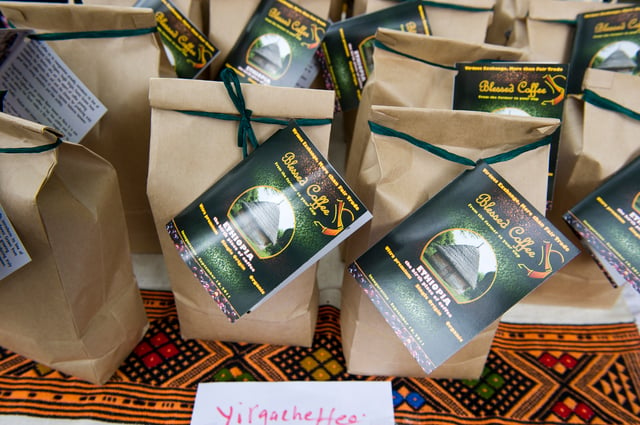
Ethiopian Blessed Coffee brand bags in Takoma Park, Maryland. Coffee is one of Ethiopia's main exports.
Exports from Ethiopia in the 2009/2010 financial year totaled US$1.4 billion.[215] The country produces more coffee than any other nation on the continent.[216]"Coffee provides a livelihood for close to 15 million Ethiopians, 16% of the population.Farmers in the eastern part of the country, where a warming climate is already impacting production, have struggled in recent years, and many are currently reporting largely failed harvests as a result of a prolonged drought".[217]
Cross-border trade by pastoralists is often informal and beyond state control and regulation.
In East Africa, over 95% of cross-border trade is through unofficial channels. The unofficial trade of live cattle, camels, sheep, and goats from Ethiopia sold to Somalia, Djibouti, and Kenya generates an estimated total value of between 250 and US$300 million annually (100 times more than the official figure).[220]
This trade helps lower food prices, increase food security, relieve border tensions, and promote regional integration.[220] However, the unregulated and undocumented nature of this trade runs risks, such as allowing disease to spread more easily across national borders.
Furthermore, the government of Ethiopia is purportedly unhappy with lost tax revenue and foreign exchange revenues.[220] Recent initiatives have sought to document and regulate this trade.[220]
With the private sector growing slowly, designer leather products like bags are becoming a big export business, with Taytu becoming the first luxury designer label in the country.[221] Additional small-scale export products include cereals, pulses, cotton, sugarcane, potatoes, and hides.
With the construction of various new dams and growing hydroelectric power projects around the country, Ethiopia also plans to export electric power to its neighbors.[222][223]
The country also has large mineral resources and oil potential in some of the less inhabited regions.
Political instability in those regions, however, has inhibited development.
Ethiopian geologists were implicated in a major gold swindle in 2008.
Four chemists and geologists from the Ethiopian Geological Survey were arrested in connection with a fake gold scandal, following complaints from buyers in South Africa.
Gold bars from the National Bank of Ethiopia were found by police to be gilded metal, costing the state around US$17 million, according to the Science and Development Network website.[226]
In 2011, the Grand Ethiopian Renaissance Dam project was commenced. When completed, it will provide surplus energy in Ethiopia which will be available for export to neighboring countries.
Transportation
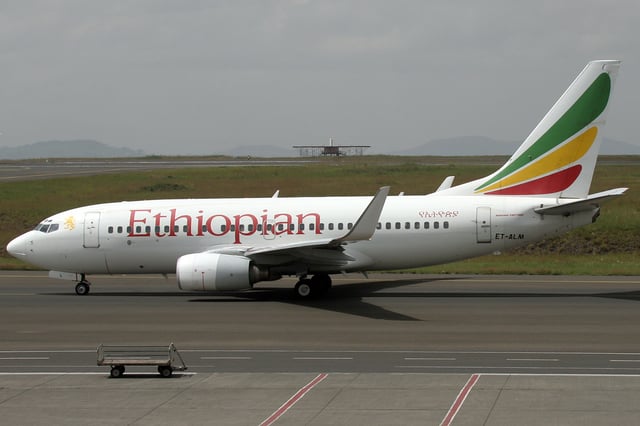
Ethiopian Airlines Boeing 737–700 on the Bole International Airport taxiway

Light rail in Addis Ababa, Ethiopia
Ethiopia has 926 km of electrified 1,435 mm (4 ft 8 1⁄2 in) standard gauge railways, 656 km for the Addis Ababa–Djibouti Railway between Addis Ababa and the Port of Djibouti (via Awash)[227] and 270 km for the Awash–Hara Gebeya Railway between Addis Ababa and the twin cities of Dessie/Kombolcha[228] (also via Awash). Both railways are either in trial service or still under construction as of August 2017. Once commissioned and fully operational in 2018/2019, both railways will allow passenger transport with a designated speed of 120 km/hour and freight transport with a speed of ~80 km/hour. Expected travel time from Addis Ababa to Djibouti City for passengers would be less than twelve hours and travel time from Addis Ababa to Dessie/Kombolcha would be around six hours.
Beyond the first 270 km of the Awash–Hara Gebeya Railway, a second construction phase over 120 km foresees the extension of this railway from Dessie/Kombolcha to Hara Gebeya/Woldiya. It is not clear, when this section will be built and opened.[229] A third, northern 216 km long railway is also under construction between Mek'ele and Woldiya, but it is also not clear, when this railway will be commissioned and opened.[230] All railways are part of a future railway network of more than 5,000 km of railways, the National Railway Network of Ethiopia.
As the first part of a ten-year Road Sector Development Program, between 1997 and 2002 the Ethiopian government began a sustained effort to improve its infrastructure of roads.
As a result, as of 2015 Ethiopia has a total (Federal and Regional) of 100,000 km of roads, both paved and gravel.[231]
Ethiopia had 58 airports as of 2012,[3] and 61 as of 2016.[232] Among these, the Bole International Airport in Addis Ababa and the Aba Tenna Dejazmach Yilma International Airport in Dire Dawa accommodate international flights. Ethiopian Airlines is the country's flag carrier, and is wholly owned by the Government of Ethiopia.[233] From its hub at the Bole International Airport, the airline serves a network of 102 international passenger, 20 domestic passenger, and 44 cargo destinations.[234][235] It is also one of the fastest-growing carriers in the industry and continent.[236]
Demographics
Ethiopia's total population has grown from 38.1 million in 1983 to 109.5 million in 2018.
[237] The population was only about 9 million in the 19th century.[238] The 2007 Population and Housing Census results show that the population of Ethiopia grew at an average annual rate of 2.6% between 1994 and 2007, down from 2.8% during the period 1983–1994. Currently, the population growth rate is among the top ten countries in the world. The population is forecast to grow to over 210 million by 2060, which would be an increase from 2011 estimates by a factor of about 2.5.[239]
| Population in Ethiopia[240] | |||
|---|---|---|---|
| Year | Million | Difference | |
| 1950 | 18.4 | – | |
| 1960 | 22.5 | 4.1 | |
| 1970 | 29.0 | 6.5 | |
| 1980 | 35.4 | 6.4 | |
| 1990 | 48.3 | 12.9 | |
| 2000 | 65.6 | 17.3 | |
| 2010 | 82.9 | 17.3 | |
| 2013 | 93.8 | 10.9 | |
| 2018 | 107.5 | 13.7 | |
The country's population is highly diverse, containing over 80 different ethnic groups.
According to the Ethiopian national census of 2007, the Oromo are the largest ethnic group in Ethiopia, at 34.4% of the nation's population. The Amhara represent 27.0% of the country's inhabitants, while Somalis and Tigrayans represent 6.2% and 6.1% of the population, respectively. Other prominent ethnic groups are as follows: Sidama 4.0%, Gurage 2.5%, Welayta 2.3%, Afar 1.7%, Hadiya 1.7%, Gamo 1.5% and Arabs and others 12.6%.[9]
Afroasiatic-speaking communities make up the majority of the population. Among these, Semitic speakers often collectively refer to themselves as the Habesha people. The Arabic form of this term (al-Ḥabasha) is the etymological basis of "Abyssinia," the former name of Ethiopia in English and other European languages.[241] Additionally, Nilo-Saharan-speaking ethnic minorities inhabit the southern regions of the country, particularly in areas of the Gambela Region which borders South Sudan. The largest ethnic groups among these include the Nuer and Anuak.
In addition, Ethiopia had over 75,000 Italian settlers during the Italian occupation of the country.[242] After independence, many Italians remained for decades after receiving full pardons from Emperor Selassie, as he saw the opportunity to continue modernization efforts.[243] However, due to the Ethiopian Civil War in 1974, nearly 22,000 Italo-Ethiopians left the country.[243] In the 2000s, some Italian companies returned to operate in Ethiopia, and a large number of Italian technicians and managers arrived with their families, residing mainly in the metropolitan area of the capital.[244]
In 2009, Ethiopia hosted a population of refugees and asylum seekers numbering approximately 135,200.
The majority of this population came from Somalia (approximately 64,300 persons), Eritrea (41,700) and Sudan (25,900).
The Ethiopian government required nearly all refugees to live in refugee camps.[245]
Languages
According to Ethnologue, there are 90 individual languages spoken in Ethiopia.[246] Most people in the country speak Afroasiatic languages of the Cushitic or Semitic branches. The former includes Oromiffa, spoken by the Oromo, and Somali, spoken by the Somalis; the latter includes Amharic, spoken by the Amhara, and Tigrinya, spoken by the Tigrayans. Together, these four groups make up about three-quarters of Ethiopia's population. Other Afroasiatic languages with a significant number of speakers include the Cushitic Sidamo, Afar, Hadiyya and Agaw languages, as well as the Semitic Gurage languages, Harari, Silt'e, and Argobba languages.[9] Arabic, which also belongs to the Afroasiatic family, is likewise spoken in some areas.[247]
Additionally, Omotic languages are spoken by Omotic ethnic minority groups inhabiting the southern regions. Among these idioms are Aari, Bench, Dime, Dizin, Gamo-Gofa-Dawro, Maale, Hamer, and Wolaytta.[9]
Languages from the Nilo-Saharan family are also spoken by ethnic minorities concentrated in the southwestern parts of the country. These languages include Nuer, Anuak, Nyangatom, Majang, Suri, Me'en, and Mursi.[9]
English is the most widely spoken foreign language, and is the medium of instruction in secondary schools.
Amharic was the language of primary school instruction, but has been replaced in many areas by regional languages such as Oromiffa, Somali or Tigrinya.[248] While all languages enjoy equal state recognition in the 1995 Constitution of Ethiopia, Amharic is recognized as the official working language of the Federal Government.[1] The various regions of Ethiopia and chartered cities are free to determine their own working languages.[248] Amharic is recognised as the official working language of Amhara Region, Benishangul-Gumuz, Southern Nations, Nationalities, and Peoples' Region, Gambela Region, Addis Abeba and Dire Dawa,[249] while Afar,[250] Harari,[251] Oromiffa,[252] Somali[253] and Tigrinya[254] are recognized as official working languages in their respective regions.
Italian, the former colonial language, is still spoken by few parts of the population, mostly among older generations, and is taught in many schools (most notably the Istituto Statale Italiano Omnicomprensivo di Addis Abeba). Also, Amharic and Tigrinya has many words borrowed from the Italian language.[255][256]
Script
Ethiopia's principal orthography is the Ge'ez script. Employed as an abugida for several of the country's languages, it first came into usage in the 6th and 5th centuries BC as an abjad to transcribe the Semitic Ge'ez language.[257] Ge'ez now serves as the liturgical language of both the Ethiopian Orthodox Tewahedo and Eritrean Orthodox Tewahedo Churches. During the 1980s, the Ethiopic character set was computerized. It is today part of the Unicode standard as Ethiopic, Ethiopic Extended, Ethiopic Supplement and Ethiopic Extended-A.
Other writing systems have also been used over the years by different Ethiopian communities. The latter include Bakri Sapalo's script for Oromiffa.[258]
Religion
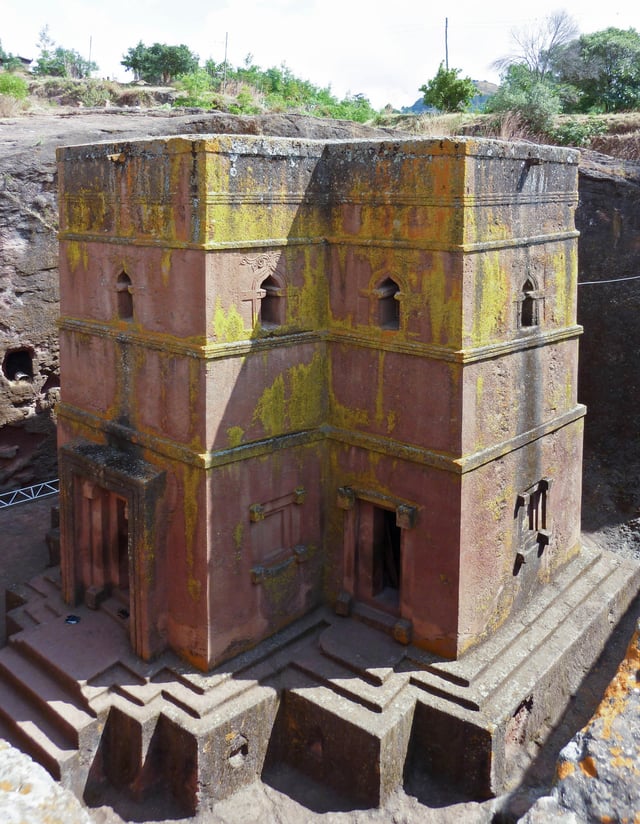
The rock-hewn Church of Saint George, Lalibela is a UNESCO World Heritage Site.
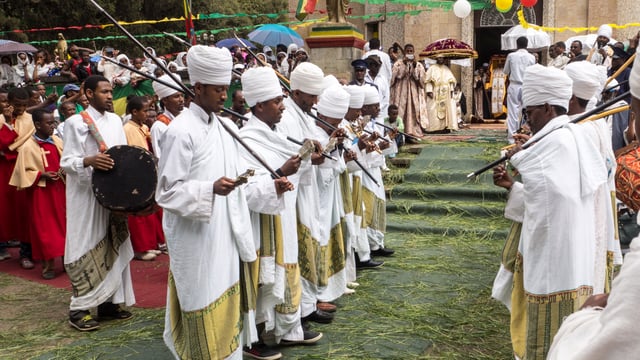
Orthodox priests dancing during the celebration of Timkat
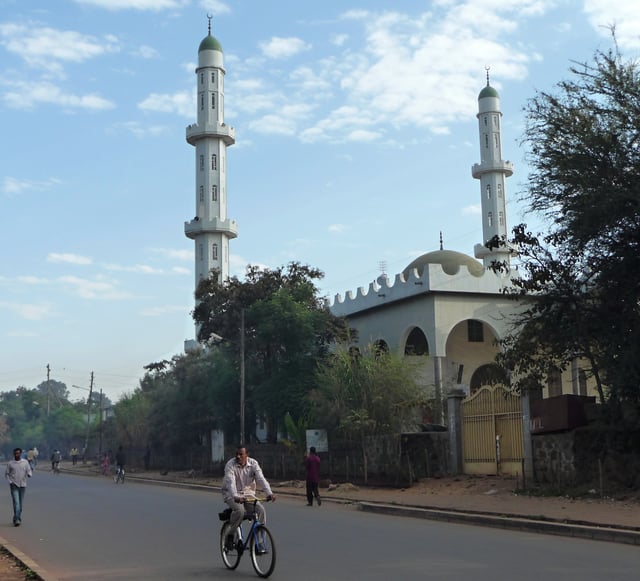
A mosque in Bahir Dar
Ethiopia has close historical ties with all three of the world's major Abrahamic religions. In the 4th century, the Ethiopian empire was one of the first in the world to officially adopt Christianity as the state religion. As a result of the resolutions of the Council of Chalcedon, in 451 the miaphysites,[259] which included the vast majority of Christians in Egypt and Ethiopia, were accused of monophysitism and designated as heretics under the common name of Coptic Christianity (see Oriental Orthodoxy). While no longer distinguished as a state religion, the Ethiopian Orthodox Tewahedo Church remains the majority Christian denomination. There is also a substantial Muslim demographic, representing around a third of the population. Additionally, Ethiopia is the site of the First Hegira, a major emigration in Islamic history. A town in the Tigray Region, Negash is the oldest Muslim settlement in Africa. Until the 1980s, a substantial population of Beta Israel (Ethiopian Jews) resided in Ethiopia.[260][261]
According to the 2007 National Census, Christians make up 62.8% of the country's population (43.5% Ethiopian Orthodox, 19.3% other denominations), Muslims 33.9%, practitioners of traditional faiths 2.6%, and other religions 0.6%.[9] This is in agreement with the CIA World Factbook, which states that Christianity is the most widely practiced religion in Ethiopia.[3] The ratio of the Christian to Muslim population has largely remained stable when compared to previous censuses conducted decades ago.[262] Sunnis form the majority of Muslims with non-denominational Muslims being the second largest group of Muslims, and the Shia and Ahmadiyyas are a minority. Sunnis are largely Shafi'is or Salafis, and there are also many Sufi Muslims there.[263] The large Muslim population in the northern Afar region has resulted in a Muslim separatist movement called the "Islamic State of Afaria" seeking a sharia-compliant constitution.[264]
The Kingdom of Aksum was one of the first polities to officially embrace Christianity, when Frumentius of Tyre, called Fremnatos or Abba Selama ("Father of Peace") in Ethiopia, converted Emperor Ezana during the fourth century.[60][260] According to the New Testament, Christianity had entered Ethiopia even earlier, when an official in the Ethiopian royal treasury was baptized by Philip the Evangelist.[265]
The Ethiopian Orthodox Tewahedo Church is part of Oriental Orthodoxy. It is by far the largest Christian denomination, although a number of P'ent'ay (Protestant) churches have recently gained ground. Since 1930, a relatively small Ethiopian Catholic Church has existed in full communion with Rome, with adherents making up less than 1% of the total population.[262][266]
Islam in Ethiopia dates back to the founding of the religion in 622 when a group of Muslims were counseled by Muhammad to escape persecution in Mecca. The disciples subsequently migrated to Abyssinia via modern-day Eritrea, which was at the time ruled by Ashama ibn-Abjar, a pious Christian emperor.[260] Also, the largest single ethnic group of non-Arab Sahabah was that of the Ethiopians.
According to the 2007 Population and Housing Census, around 1,957,944 people in Ethiopia are adherents of traditional religions. An additional 471,861 residents practice other creeds.[9] While followers of all religions can be found in each region, they tend to be concentrated in certain parts of the country. Christians predominantly live in the northern Amhara and Tigray regions, and are largely members of the non-Chalcedonian Ethiopian Orthodox Tewahedo Church. Those belonging to P'ent'ay are centered in the Southern Nations, Nationalities, and Peoples' Region (SNNP) and Oromia. Muslims in Ethiopia predominantly adhere to Sunni Islam and generally inhabit eastern and northeastern areas; particularly the Somali, Afar, Dire Dawa and Harari regions. Practitioners of traditional religions mainly reside in the nation's far southwestern and western rural borderlands, in the SNNP, Benishangul-Gumuz and Gambela regions.[9][260]
Human rights groups have regularly accused the government of arresting activists, journalists and bloggers to stamp out dissent among some religious communities. Lengthy prison terms were handed to 17 Muslim activists on 3 August 2015 ranging from seven to 22 years. They were charged with trying to create an Islamic state in the majority Christian country. All the defendants denied the charges and claimed that they were merely protesting in defence of their rights.[267][268][269]
Beta Israel
There is a small, yet significant number of Jews in Ethiopia, who claim to be one of the lost tribes of Israel. In the 1980s, the number of Ethiopian-Jews decreased, as many started moving to Israel. The tribe has been given the name ‘Beta Israel/ቤታ እስራኤል/ביתא ישראל‘. There are a higher number of Ethiopian-Jews living in Israel today, though, in certain Ethiopian towns and villages such as Wolleka, near the Ethiopian city of Gondar, the concentration of Ethiopian-Jews reaches an estimated 100%. The US also has a significant number of Ethiopian-Jews, with a population slightly less than that of Ethiopia.
Urbanization
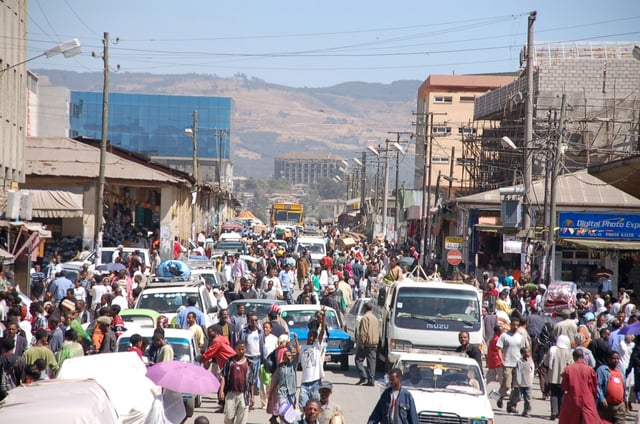
Street in Addis Abeba
Population growth, migration, and urbanization are all straining both governments' and ecosystems' capacity to provide people with basic services.[270] Urbanization has steadily been increasing in Ethiopia, with two periods of significantly rapid growth.
First, in 1936–1941 during the Italian occupation under Mussolini's fascist government, and from 1967 to 1975 when the populations of urban centers tripled.[271]
In 1936, Italy annexed Ethiopia, building infrastructure to connect major cities, and a dam providing power and water.[272] This along with the influx of Italians and labourers was the major cause of rapid growth during this period.
The second period of growth was from 1967 to 1975 when rural populations migrated to urban centers seeking work and better living conditions.[271]
This pattern slowed due to the 1975 Land Reform program instituted by the government, which provided incentives for people to stay in rural areas.
As people moved from rural areas to the cities, there were fewer people to grow food for the population.
The Land Reform Act was meant to increase agriculture since food production was not keeping up with population growth over the period of 1970–1983.
This program proliferated the formation of peasant associations, large villages based on agriculture.
The act did lead to an increase in food production, although there is debate over the cause; it may be related to weather conditions more than the reform act.[273] Urban populations have continued to grow with an 8.1% increase from 1975 to 2000.[274]
Rural and urban life
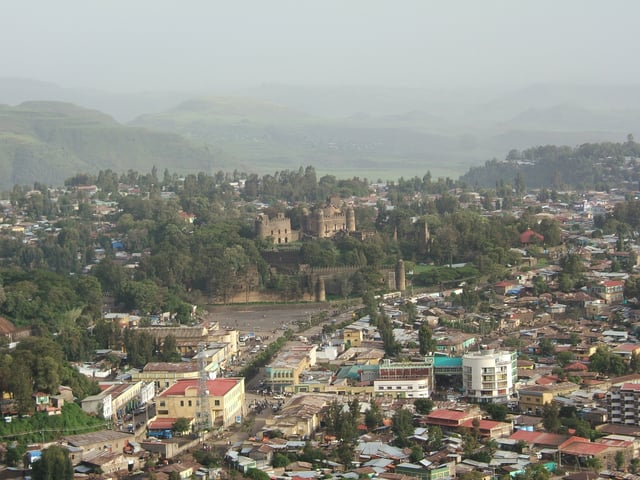
Gondar skyline
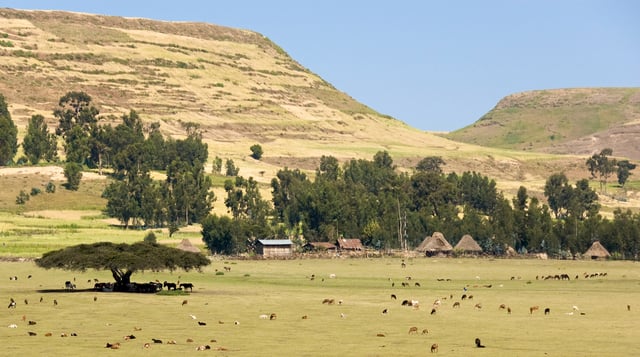
Rural area in the Simien Mountains National Park
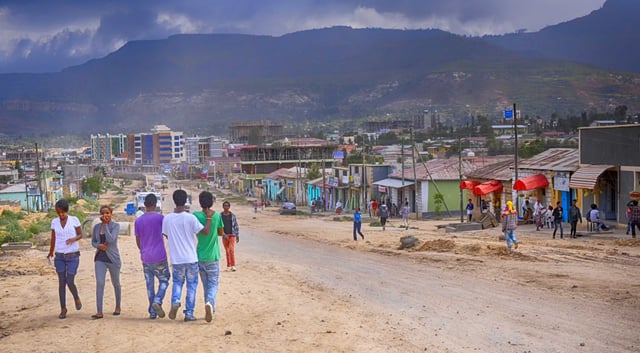
Street scene in Adigrat
Migration to urban areas is usually motivated by the hope of better lives.
In peasant associations daily life is a struggle to survive.
About 16% of the population in Ethiopia are living on less than 1 dollar per day (2008).
Only 65% of rural households in Ethiopia consume the World Health Organization's minimum standard of food per day (2,200 kilocalories), with 42% of children under 5 years old being underweight.[275]
Most poor families (75%) share their sleeping quarters with livestock, and 40% of children sleep on the floor, where nighttime temperatures average 5 degrees Celsius in the cold season.[275] The average family size is six or seven, living in a 30-square-meter mud and thatch hut, with less than two hectares of land to cultivate.[275]
The peasant associations face a cycle of poverty.
Since the landholdings are so small, farmers cannot allow the land to lie fallow, which reduces soil fertility.[275] This land degradation reduces the production of fodder for livestock, which causes low milk yields.[275] Since the community burns livestock manure as fuel, rather than plowing the nutrients back into the land, the crop production is reduced.[275] The low productivity of agriculture leads to inadequate incomes for farmers, hunger, malnutrition and disease. These unhealthy farmers have difficulty working the land and the productivity drops further.[275]
Although conditions are drastically better in cities, all of Ethiopia suffers from poverty and poor sanitation. However, poverty in Ethiopia fell from 44% to 29.6% during 2000–2011, according to the World Bank.[276] In the capital city of Addis Ababa, 55% of the population used to live in slums.[272] Now, however, a construction boom in both the private and public sector has led to a dramatic improvement in living standards in major cities, particularly in Addis Ababa. Notably, government-built condominium housing complexes have sprung up throughout the city, benefiting close to 600,000 individuals.[277] Sanitation is the most pressing need in the city, with most of the population lacking access to waste treatment facilities. This contributes to the spread of illness through unhealthy water.[272]
Despite the living conditions in the cities, the people of Addis Ababa are much better off than people living in the peasant associations owing to their educational opportunities.
Unlike rural children, 69% of urban children are enrolled in primary school, and 35% of those are eligible to attend secondary school.[272] Addis Ababa has its own university as well as many other secondary schools. The literacy rate is 82%.[272]
Health
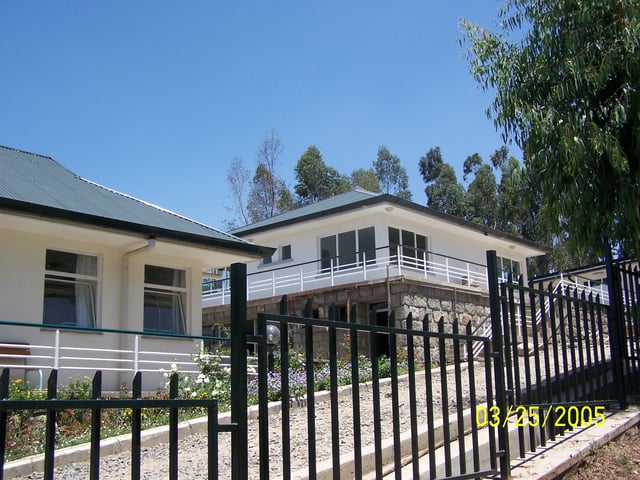
Addis Ababa Fistula Hospital
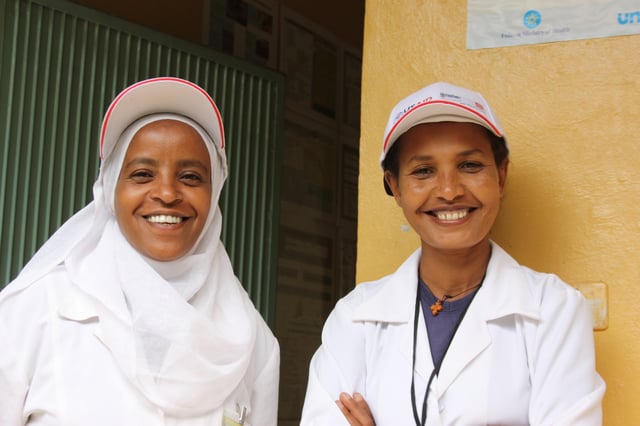
Community health care workers
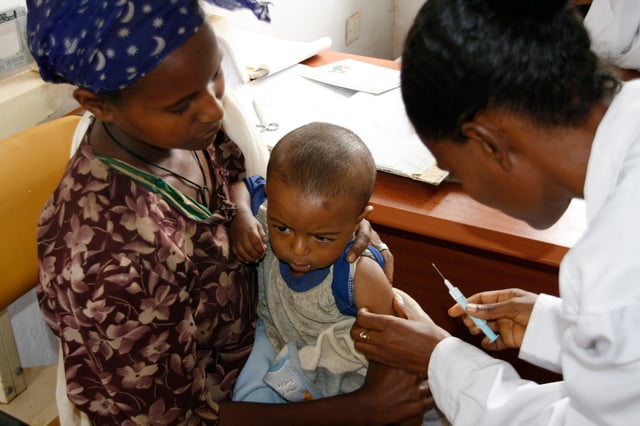
An Ethiopian girl about to receive her measles vaccine
The World Health Organization's 2006 World Health Report gives a figure of 1,936 physicians (for 2003),[278] which comes to about 2.6 per 100,000. Globalization is said to affect the country, with many educated professionals leaving Ethiopia for better economic opportunities in the West.
Ethiopia's main health problems are said to be communicable (contagious) diseases worsened by poor sanitation and malnutrition.
Over 44 million people (more than half the population) do not have access to clean water.[279] These problems are exacerbated by the shortage of trained doctors and nurses and health facilities.[280]
The state of public health is considerably better in the cities.
Birth rates, infant mortality rates, and death rates are lower in cities than in rural areas due to better access to education, medicines, and hospitals.[272] Life expectancy is better in cities compared to rural areas, but there have been significant improvements witnessed throughout the country in recent years, the average Ethiopian living to be 62.2 years old, according to a UNDP report.[281] Despite sanitation being a problem, use of improved water sources is also on the rise; 81% in cities compared to 11% in rural areas.[274] As in other parts of Africa, there has been a steady migration of people towards the cities in hopes of better living conditions.
There are 119 hospitals (12 in Addis Ababa alone) and 412 health centers in Ethiopia.[282] Infant mortality rates are relatively high, as 41 infants die per 1,000 live births.[283] Ethiopia has been able to reduce under-five mortality by two-thirds (one of the Millennium Development Goals) since 1990 [282] Although this is a dramatic decrease, birth-related complications such as obstetric fistula affect many of the nation's women.
The HIV AIDS prevalence rate in Ethiopia stood at 1.1% in 2014, a dramatic decrease from 4.5% 15 years ago.
The most affected are poor communities and women, due to lack of health education, empowerment, awareness and lack of social well-being.
The government of Ethiopia and many private organizations like World Health Organization (WHO), and the United Nations, are launching campaigns and are working aggressively to improve Ethiopia's health conditions and promote health awareness on AIDS and other communicable diseases (Dugassa, 2005).
Ethiopia has a relatively high infant and maternal mortality rate.
Although, Ethiopia did not meet the MDG target of reducing maternal mortality rate by two thirds in 2015, there are improvements nonetheless.
For instance, the contraception prevalence rate increased from 8.1% in 2000 to 41.8% in 2014, and Antenatal care service coverage increase from 29% to an astounding 98.1% in the same period.
Currently, the maternal mortality rate stands at 420 per 100,000 live births.
Only a minority of Ethiopians are born in hospitals, while most are born in rural households.
Those who are expected to give birth at home have elderly women serve as midwives who assist with the delivery (Kater, 2000).
The "WHO estimates that a majority of maternal fatalities and disabilities could be prevented if deliveries were to take place at well-equipped health centers, with adequately trained staff" (Dorman et al., 2009, p. 622).
The low availability of health-care professionals with modern medical training, together with lack of funds for medical services, leads to the preponderance of less-reliable traditional healers that use home-based therapies to heal common ailments.
One common cultural practice, irrespective of religion or economic status, is female genital mutilation (FGM), also known as female genital cutting (FGC), a procedure that involves partial or total removal of the external female genitalia, or other injury to the female genital organs for non-medical reasons.[284] The practice has been made illegal in Ethiopia in 2004.[285] FGM is a pre-marital custom mainly endemic to Northeast Africa and parts of the Near East that has its ultimate origins in Ancient Egypt.[286][287] Encouraged by women in the community, it is primarily intended to deter promiscuity and to offer protection from assault.[288]
The country has a high prevalence of FGM, but prevalence is lower among young girls.
Ethiopia's 2005 Demographic and Health Survey (EDHS) noted that the national prevalence rate is 74% among women ages 15–49.[289] The practice is almost universal in the regions of Dire Dawa, Somali, and Afar. In the Oromo and Harari regions, more than 80% of girls and women undergo the procedure. FGC is least prevalent in the regions of Tigray and Gambela, where 29% and 27% of girls and women, respectively, are affected.[290] According to a 2010 study performed by the Population Reference Bureau, Ethiopia has a prevalence rate of 81% among women ages 35 to 39 and 62% among women ages 15–19.[291] A 2014 UNICEF report found that only 24% of girls under 14 had undergone FGM.[292]
Male circumcision is also practiced in the country, and about 76% of Ethiopia's male population is reportedly circumcised.[293]
The Government of the Federal Republic of Ethiopia is signatory to various international conventions and treaties that protect the rights of women and children.
Its constitution provides for the fundamental rights and freedoms for women.
There is an attempt being made to raise the social and economic status of women through eliminating all legal and customary practices, which hinder women's equal participation in society and undermine their social status.
The National Mental Health Strategy, published in 2012, introduced the development of policy designed to improve mental health care in Ethiopia.
This strategy mandated that mental health be integrated into the primary health care system.[294] However, the success of the National Mental Health Strategy has been limited.
For example, the burden of depression is estimated to have increased 34.2% from 2007 to 2017.[295] Furthermore, the prevalence of stigmatizing attitudes, inadequate leadership and co-ordination of efforts, as well as a lack of mental health awareness in the general population, all remain as obstacles to successful mental health care.[296]
Education
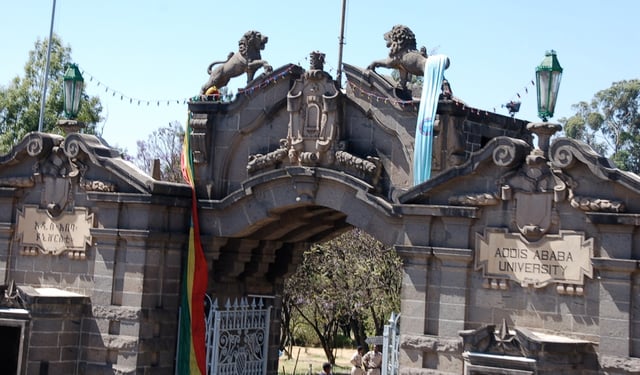
Entrance of Addis Ababa University.
Education in Ethiopia was dominated by the Tewahedo Church for many centuries until secular education was adopted in the early 1900s.
The current system follows school expansion schemes which are very similar to the system in the rural areas during the 1980s, with an addition of deeper regionalization, providing rural education in students' own languages starting at the elementary level, and with more budget finances allocated to the education sector.
The sequence of general education in Ethiopia is six years of primary school, four years of lower secondary school and two years of higher secondary school.[297]
Access to education in Ethiopia has improved significantly.
Approximately 3 million people were in primary school in 1994/95, and by 2008/09, primary enrolment had risen to 15.5 million – an increase of over 500%.[298] In 2013/14, the country had witnessed significant boost in gross enrolment across all regions.[299] The national GER was 104.8% for boys, 97.8% for girls and 101.3% across both sexes.[300]
The literacy rate has increased in recent years: according to the 1994 census, the literacy rate in Ethiopia was 23.4%.[246] In 2007 it was estimated to be 39% (male 49.1% and female 28.9%).[301] A report by UNDP in 2011 showed that the literacy rate in Ethiopia was 46.7%. The same report also indicated that the female literacy rate has increased from 27 to 39 percent from 2004 to 2011, and the male literacy rate has increased from 49 to 59 percent over the same period for persons 10 years and older.[302] By 2015, the literacy rate had further increased, to 49.1% (57.2% male and 41.1% female).[303]
Culture
Naming
Ethiopians have a different naming system to the family name-based Western system. Children add the given names of their father and paternal grandfather consecutively to their own given name. For compatibility purposes, as is done in passports, the grandfather's given name is taken as a family surname, and a person's given name and their father's given name form the first names.
Everyone is addressed by their given name.
In official situations, the prefixes Ato (አቶ) is used for men; Weyzero (ወይዘሮ) for married women; and Weyzerīt (ወይዘሪት) for unmarried women.
Calendar
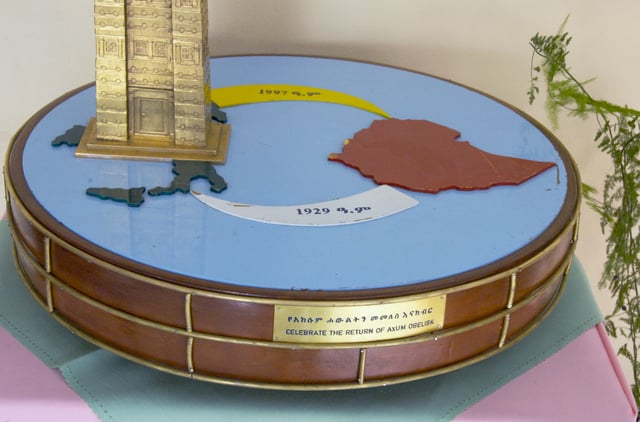
Model commemorating the Obelisk of Aksum's return to Ethiopia from Italy, showing the date of its departure and return according to the Ethiopian calendar
Ethiopia has several local calendars.
The most widely known is the Ethiopian calendar, also known as the Ge'ez calendar. It is based on the older Alexandrian or Coptic calendar, which in turn derives from the Egyptian calendar. Like the Coptic calendar, the Ethiopian calendar has twelve months of exactly 30 days each plus five or six epagomenal days, which comprise a thirteenth month. The Ethiopian months begin on the same days as those of the Coptic calendar, but their names are in Ge'ez.
Like the Julian calendar, the sixth epagomenal day—which in essence is a leap day—is added every four years without exception on 29 August of the Julian calendar, six months before the Julian leap day. Thus, the first day of the Ethiopian year, 1 Mäskäräm, for years between 1901 and 2099 (inclusive), is usually 11 September (Gregorian), but falls on 12 September in years before the Gregorian leap year. Also, a seven- to eight-year gap between the Ethiopian and Gregorian calendars results from an alternate calculation in determining the date of the Annunciation of Jesus.
Another prominent calendrical system was developed around 300 BC by the Oromo. A lunar-stellar calendar, this Oromo calendar relies on astronomical observations of the moon in conjunction with seven particular stars or constellations. Oromo months (stars/lunar phases) are Bittottessa (Iangulum), Camsa (Pleiades), Bufa (Aldebarran), Waxabajjii (Belletrix), Obora Gudda (Central Orion-Saiph), Obora Dikka (Sirius), Birra (full moon), Cikawa (gibbous moon), Sadasaa (quarter moon), Abrasa (large crescent), Ammaji (medium crescent), and Gurrandala (small crescent).[304]
Time
Time in Ethiopia is counted differently from most countries. The Ethiopian day is reckoned as beginning at 06:00 as opposed to 00:00, coinciding with sunrise throughout the year. To convert between the Ethiopian clock and Western clocks, one must add (or subtract) 6 hours to the Western time. For example, 02:00 local Addis Ababa time is called "8 at night" in Ethiopia, while 20:00 is called "2 in the evening".
Cuisine

Typical Ethiopian cuisine: Injera (pancake-like bread) and several kinds of wat (stew)
The best-known Ethiopian cuisine consists of various types of thick meat stews, known as wat in Ethiopian culture, and vegetable side dishes served atop injera, a large sourdough flatbread made of teff flour. This is not eaten with utensils, but instead one uses the injera to scoop up the entrées and side dishes. Almost universally in Ethiopia, it is common to eat from the same dish in the center of the table with a group of people. It is also a common custom to feed others in your group with your own hands—a tradition referred to as "gursha".[305] Traditional Ethiopian cuisine employs no pork or shellfish of any kind, as they are forbidden in the Ethiopian Orthodox Christian, Islamic and Jewish faiths.
Chechebsa, marqa, chukko, michirra and dhanga are the most popular dishes from the Oromo. Kitfo, which originated among the Gurage, is one of the country's most popular delicacies. In addition, Doro wot ("ደሮ ወጥ" in Amharic) and Tsebehi derho ("ጽብሒ ድርሆ" in Tigrinya), are other popular dishes, originating from northwestern Ethiopia. Tihlo (ጥሕሎ)—which is a type of dumpling—is prepared from roasted barley flour and originated in the Tigray Region. However, it is now very popular in Amhara and spreading further south.[306]
Media
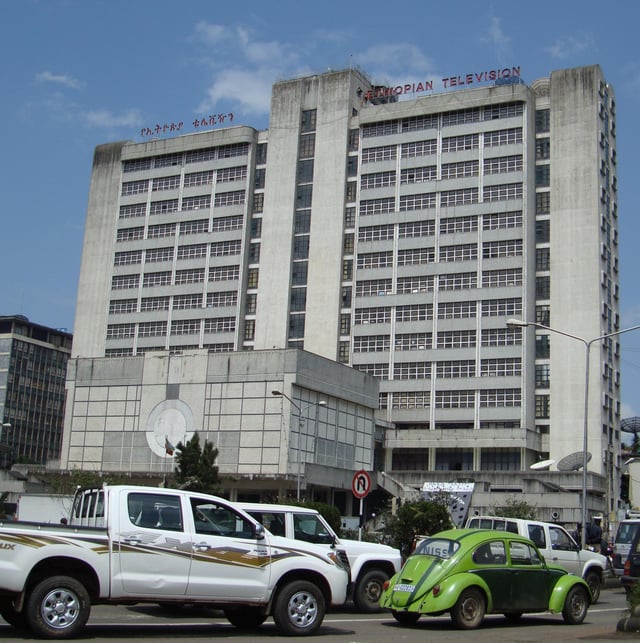
The Ethiopian Broadcasting Corporation headquarters in Addis Ababa
Ethiopian Broadcasting Corporation (EBC), formerly known as ETV, is the government-owned national channel. Other television stations in the country include Kana TV.
The most widely circulated newspapers in Ethiopia are Addis Fortune, Capital Ethiopia, Ethiopian Reporter, Addis Zemen (Amharic) and Ethiopian Herald.
The sole internet service provider is the national telecommunications firm Ethio Telecom. A large portion of users in the country access the internet through mobile devices.[307] As of July 2016, there are around 4.29 million people who have internet access at their home as compared to a quarter of a million users a decade before that.[308] The Ethiopian government has at times intentionally shut down internet service in the country or restricted access to certain social media sites during periods of political unrest. In August 2016, following protest and demonstration in the Oromia Region, all access to the internet was shut down for a period of two days.[309] In June 2017, the government shut down access to the internet for mobile users during a period that coincided with the administration of Ethiopia's university entrance examination. Although the reason for the restriction was not confirmed by the government,[307] the move was similar to a measure taken during the same period in 2016, after a leak of test questions.[310][311]
Music
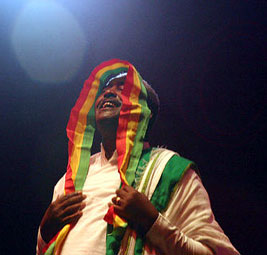
Mahmoud Ahmed, an Ethiopian singer of Gurage ancestry (2005)
The music of Ethiopia is extremely diverse, with each of the country's 80 ethnic groups being associated with unique sounds. Ethiopian music uses a distinct modal system that is pentatonic, with characteristically long intervals between some notes. As with many other aspects of Ethiopian culture and tradition, tastes in music and lyrics are strongly linked with those in neighboring Eritrea, Somalia, Djibouti, and Sudan.[312][313] Traditional singing in Ethiopia presents diverse styles of polyphony (heterophony, drone, imitation, and counterpoint). Traditionally, lyricism in Ethiopian song writing is strongly associated with views of patriotism or national pride, romance, friendship, and a most unique type of memoire known as 'Tizita'.
Sport

The Addis Ababa Stadium in Addis Ababa, built by Italian settlers in 1940
The main sports in Ethiopia are track and field (particularly long distance running) and football. Ethiopian athletes have won many Olympic gold medals in track and field, most of them in long distance running.[314] Haile Gebrselassie is a world-renowned long distance runner with several world records under his belt. Kenenisa Bekele and Tirunesh Dibaba are also dominant runners, particularly in the 5,000 and 10,000 meters in which they hold the world records.
Other notable Ethiopian athletes are Abebe Bikila, Mamo Wolde, Miruts Yifter, Derartu Tulu, Meseret Defar, Almaz Ayana, Birhane Adere, Tiki Gelana, Genzebe Dibaba, Tariku Bekele, and Gelete Burka. As of 2012 and going into 2013, the current national Ethiopian national football team (nicknamed the Walayia Antelopes) made history by qualifying for the 2012 Africa Cup of Nations and reached the last 10 African football teams in the last stage of qualification for the 2014 FIFA World Cup. Noted players include captain Adane Girma and top scorer Saladin Said.
Ethiopia has sub-Saharan Africa's longest basketball tradition as it established a national basketball team in 1949.
See also
Index of Ethiopia-related articles
Outline of Ethiopia